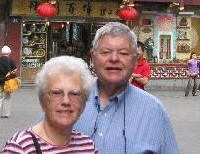|
|
|
Sep/Oct 2009
|
Day One Departure from Portland, Oregon: Itís a Long Way We got to the
Portland airport about 7:00 p.m. and realized that we were about to
undertake a series of flights that would take about 24 hours. After
a short hop to San Francisco, we went through additional security to
board the Cathay Pacific aircraft that would take us to Hong Kong,
about 13 Ĺ hours away. We waited for about an hour while a faulty
fuel gauge was checked, getting in the air about 2:30 a.m. just in
time for dinner. The flight crew was mostly Asian and very
efficient; the pilot was Australian.
The lights dimmed and we attempted to get some sleep. At one
point Cup Ďo Noodles was served with chop sticks (amazingly easy to
eat that way) and about 5 a.m. China time, breakfast was served. We
landed sometime after six. It was pouring down rain in Hong Kong as
they were experiencing the remnants of a typhoon, but we never left
the airport. There werenít too many in the terminal and as we
approached, they put on facemasks. At one point we passed the
sensors screening out anyone with an elevated body temperature. We
all passed. (Rod had to take off his hat so they could get an
accurate reading.)
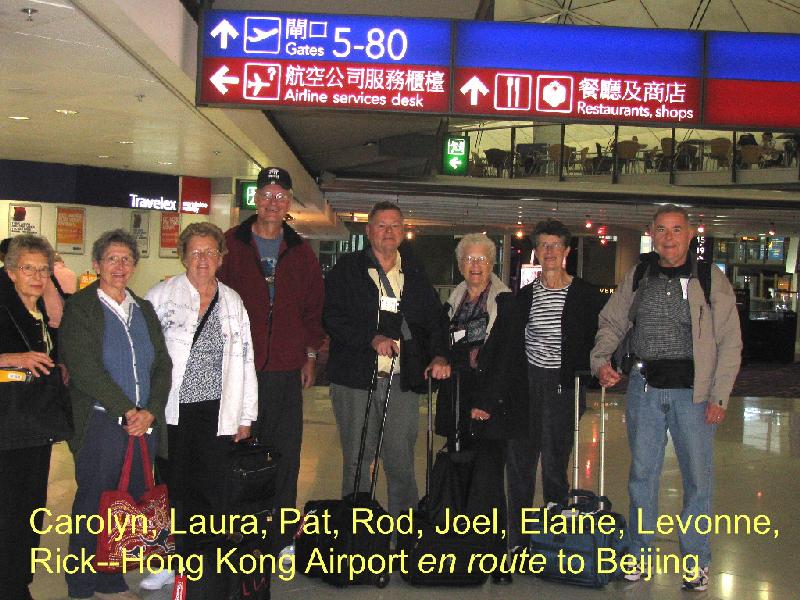
We didnít have much time before we boarded our Dragonair flight
for Beijing. It was a large Airbus, but not more than 1/3 full for
the 2 Ĺ hour flight. We had breakfast/lunch on the way. Unlike here,
airlines in China still serve food. We arrived in BeijingĎs new
terminal and passed through customs without much difficulty as soon
as our bags arrived on a later plane. Our tour guide was there to
meet us and take us to our hotel in the area called the Manhattan of
Beijing. It is a Hilton with a dťcor that seems more European than
American to me. We had several hours to walk around the
neighborhood. We went to a grocery to buy water since we were told
by our guide that we shouldnít use the water in the hotel even for
brushing our teeth. We also found a bank to get some local currency.
Larger places will take dollars, but for smaller businesses or
tipping itís nice to have local money. They use Yuan and 1 Yuan
equals about 15 cents.
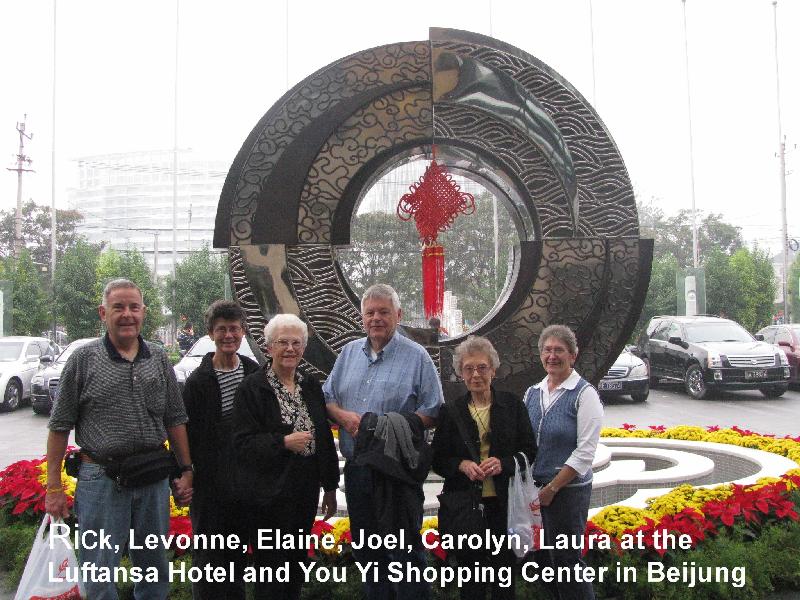
We were surprised by all the help we see in every business. In
the grocery, which was small, there were a dozen or so employees in
the aisles mostly talking with one another. The hotel has even more
in the lobby, and restaurants have plenty of servers. Our guide met
us in the evening before we had completely collapsed to take us out
to experience some local cuisine. She said that they like chefs from
Schechwan (sp) because they were such good cooks, but that they had
to tone down the spices for this area. In northern Chine, wheat is
the staple while in the South, itís rice. We were seated at large
round tables with lazy susans in the middle. They then proceeded to
bring out numerous dishes. Too full, we fell into bed by about 8
p.m. We are to be ready to go by 8 a.m., and weíre sure weíll be up
and ready. |
Hello again. It was easy to get up early today despite all the
travel of the day(s) before. We fell asleep early, for me at least,
and were ready to go before 6. Breakfast was in the hotel: a buffet
with every kind of food imaginable. We could choose from Chinese,
Korean, Japanese, European, you name it. Prices are high here and I
was glad I had already paid for the $30 mealóeach. We had been told
to meet our tour guide in the lobby at 8 sharp. She would wait 7
minutes, but then we would be off. There are 20 in our group, the 8
of us, 2 from Maryland and the rest from Saskatchewan and Toronto,
who were all there ready to go. It turns out that we are an
especially compatible group which makes it all easy. We have a
larger bus with two doors so getting on and off is fast.
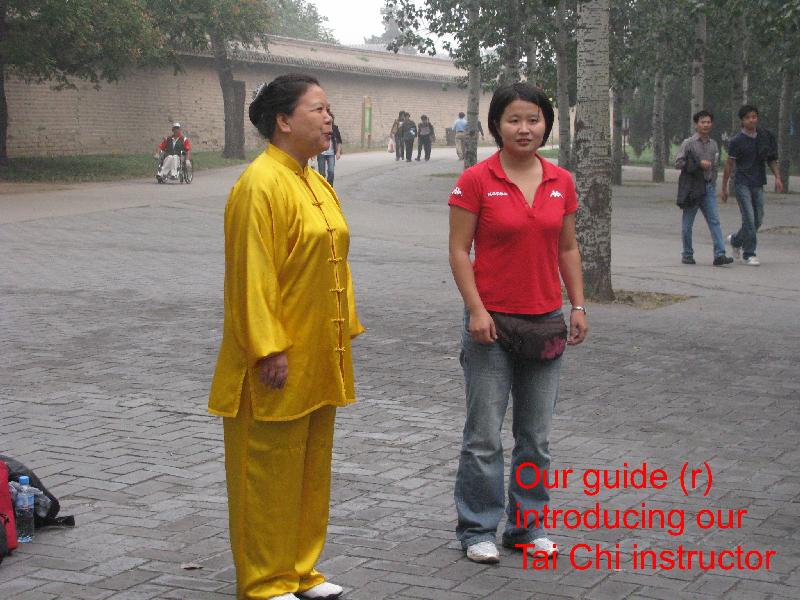
Our tour guide is ďJessica,Ē not a name her mother chose, but one
she picked for herself to make it easier for Western foreigners like
us. Her Chinese name is ChenJiang Ping, I believe. She is 30, married
to a man who has a compatible sign her mother approved of, whom she
met over the internet. She has one child, the maximum number allowed
by the government, a little girl 16 mos. She has someone to look
after her in addition to her mother. Jessica was born in the first
year of the one child per couple policy and although it was a
disappointment to her parents, she approves of the policy. Only
children have their advantages. She went to university and majored
in the hospitality business.
Jessica had a very difficult first day since Oct. 1, as you may
have seen, is the 60th anniversary of the establishment of the
Chinese Republic. It is also the time of a big holiday every year in
China. There is heightened security and many closures due to the
celebration. Places and streets are not all closed at the same time
and she has been on the cell phone often to hear the latest
announcements. Traffic congestion is not normal either. It turns out
that we have had advantages as well. Many people stayed home so they
could watch the ceremonies on TV easing crowding at places of
interest.
Today, as yesterday, the smog is unbelievable. You will notice in
pictures, Iím sure, unless we are able to filter it out. It is a bit
bothersome to the respiratory tract, but mostly to the views. We can
well understand the concern during the Olympics and heard about the
precautions taken like cars being driven on odd and even days
according to license numbers.
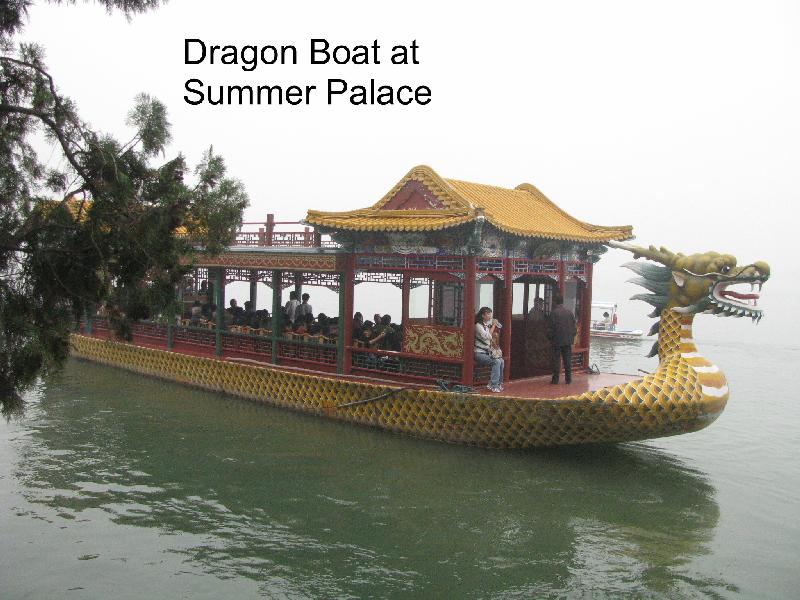
Our
first stop was the Summer Palace where the emperor and empress went
to enjoy the vast gardens and lake. It is about a mile square and we
walked through a good bit of it and took a boat across the lake to
get to our bus on the other side. There is a Ĺ mile walkway along
the lake that has a colonnade with a roof made of wood and
elaborately painted with typical Chinese naturescapes. It was
painted over during the Cultural Revolution, but has been restored.
We saw the palace where the
Dragon Lady lived, a long story involving her conniving to have the
emperor put under house arrest. It is the story told in the movie
ďThe Last Emperor,Ē which we all want to go back and see again.
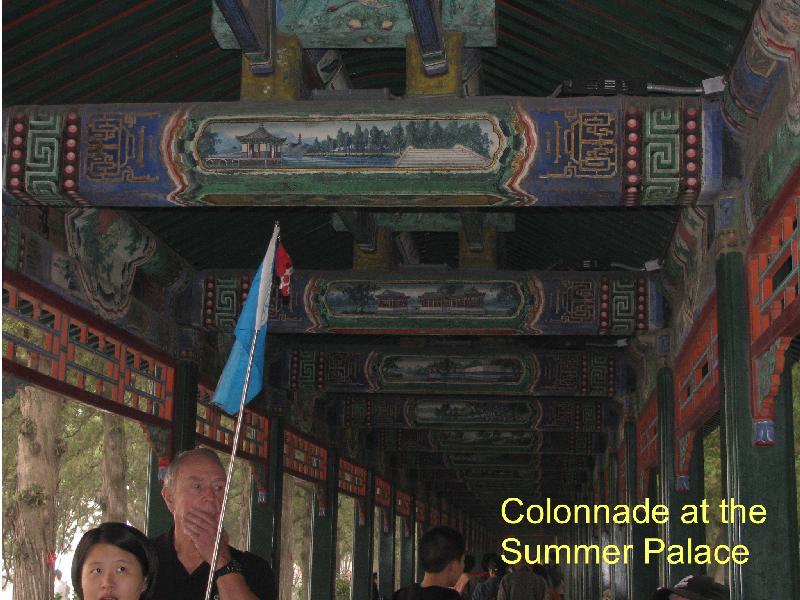
After lunch at a restaurant, we did a drive-by past Tian An Men
Square and the Forbidden City on a boulevard not normally used by
buses. It was to be closed shortly, and we thought our driver brave
against all that security. We will return to the area later, but the
square may continue to be closed. Our destination was the
backstreets of Beijing, a hutong, with narrow winding streets for a
peddycab ride. We were driven to the home of Mr. and Mrs. Woo, who
open their very modest home to visitors. A retired couple, they were picked by the
government some time back to host foreign visitors. One of them was
Henry Kissinger. We sat in their living room and they told about
their family. They had owned the home for many years until after the
revolution when the government took it over and insisted that they
have other families move in. About 20 years ago, they were able to
get it back. They have a courtyard and their two sons, wives and a
granddaughter live there. We bid them adieu and it was back to the
bus in the same peddycabs. (An odd spelling, but thatís what the
guide book says.) Rod, Rick and I gave a good tip considering how
big we are compared to the average Chinese.
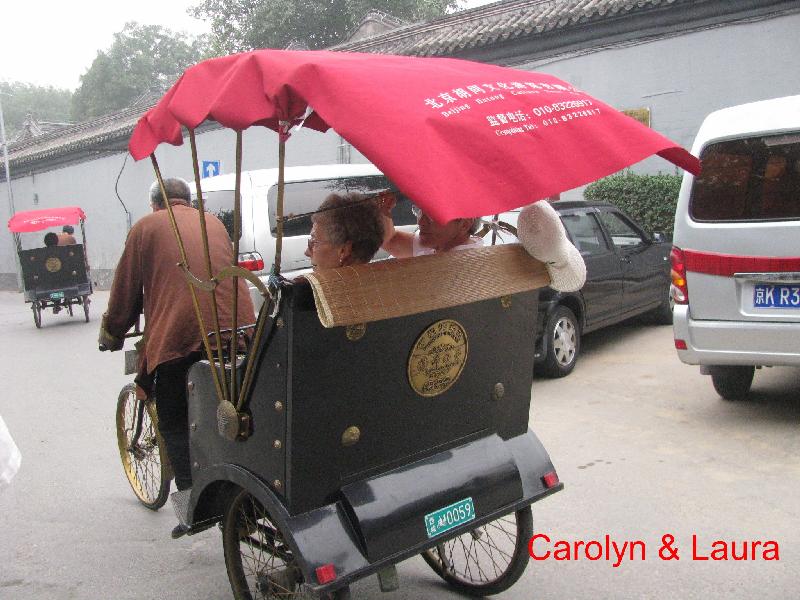
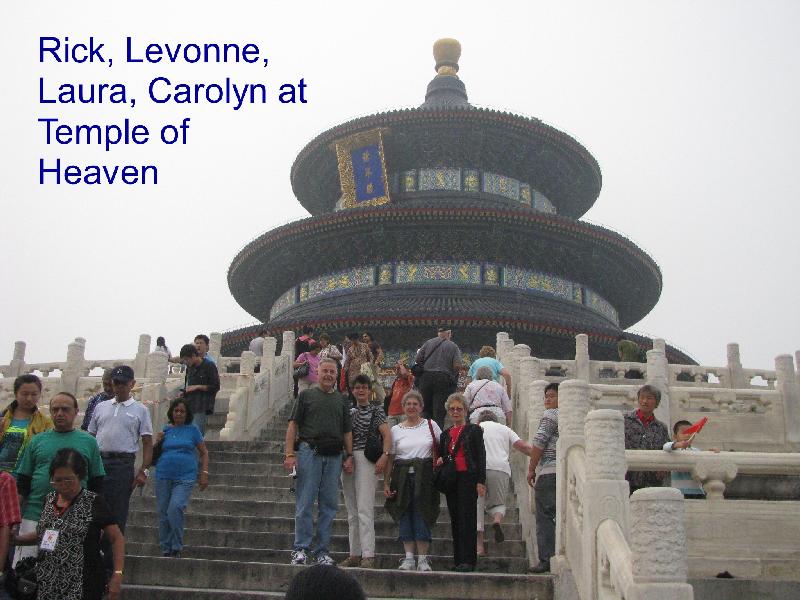
After a visit to the Temple of Heaven, we were taken to a
restaurant for a Beijing (Peking) Duck dinner. The duck takes awhile
to cook and we almost ate too much of what was served first to eat
much of the honored guest when it arrived, complete with a chef to
carve it for us. There is a complicated process of eating it with
sugar, cucumber, onion, garlic, a sauce, and won ton to wrap it in
demonstrated by one of the waitresses. Back to the hotel and to bed.
A very busy day, wouldnít you agree?
|
|
Today began in a grand fashion. After the largest flyover of
planes seeding the clouds, there was a big rainstorm at night and
the day dawned bright and sunny. Itís October 1, the 60th
anniversary celebration of the founding of the Peoples Republic of
China. Nearly everyone stayed home so that they could watch all the
festivities on t.v. , so much the better for us. We were off for the
Great Wall, or at least a small part of it about an hourís drive
from Beijing. Before arriving we could see the mountains with the
wall snaking up one side and the other. There is a big visitorís
center to handle the crowds of Chinese who all hope someday in their
lives to visit. Mao said that one couldnít understand the struggle
without visiting the wall. We had two choices, the right or the left
to begin our ascent. We were told that the one way was easier, but
more crowded. We chose the route less traveled and were rewarded by
not having to wait for others. Lest that sound like bravado, they
both seemed to go to about the same height.
The weather was about as perfect as it could get: 70, bright
sunshine, and a breeze. The views are truly awesome and even though
weíve all seen hundreds of pictures, none of them do it justice.
(And, no, itís not the only man-made object that can be seen from
space. It canít.) It took us about 1 Ĺ hrs. to climb as far as we
wanted to go, but only Ĺ hr. to return to the base station where we
enjoyed a buffet lunch.
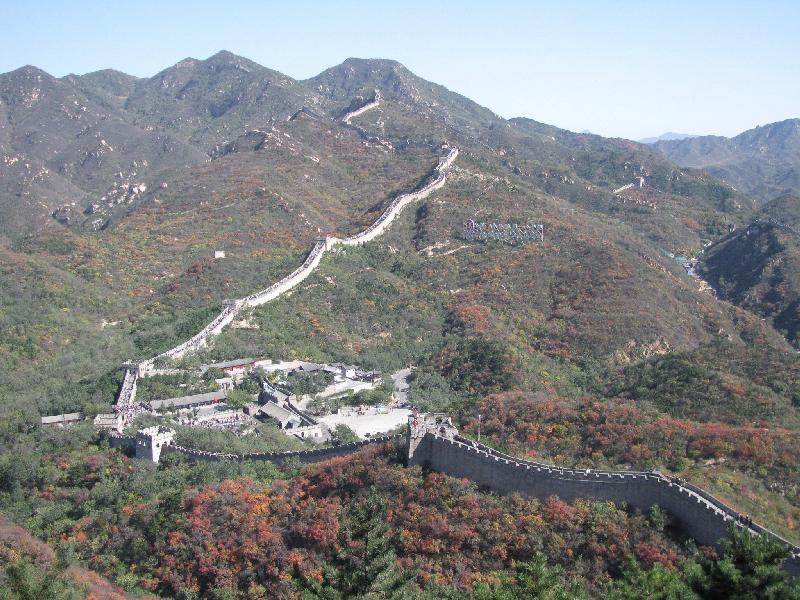
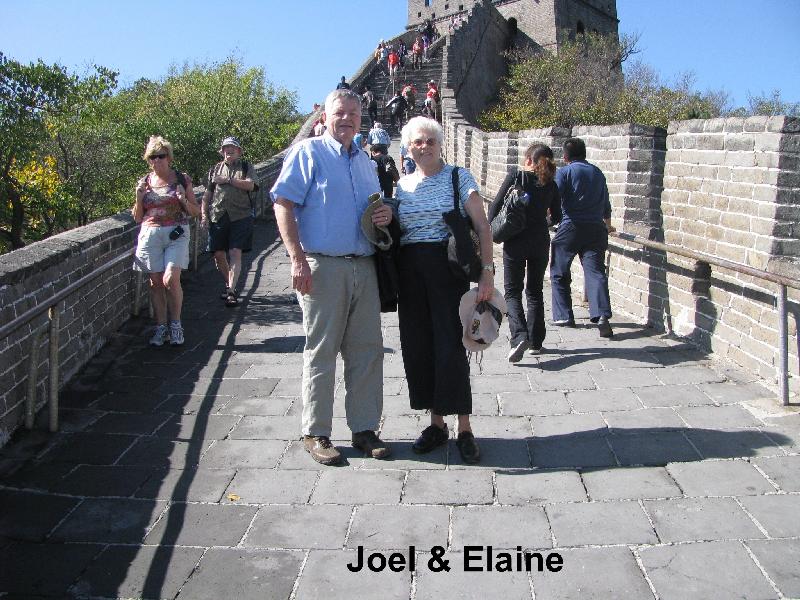
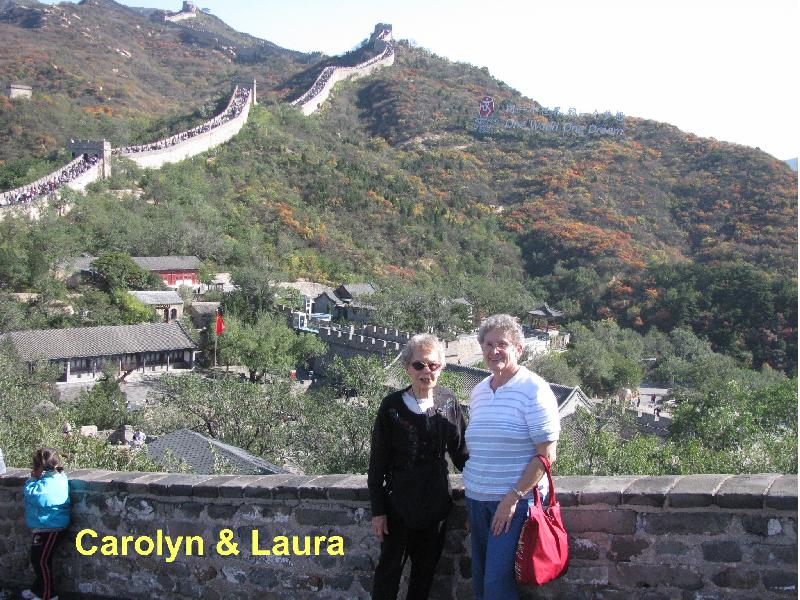

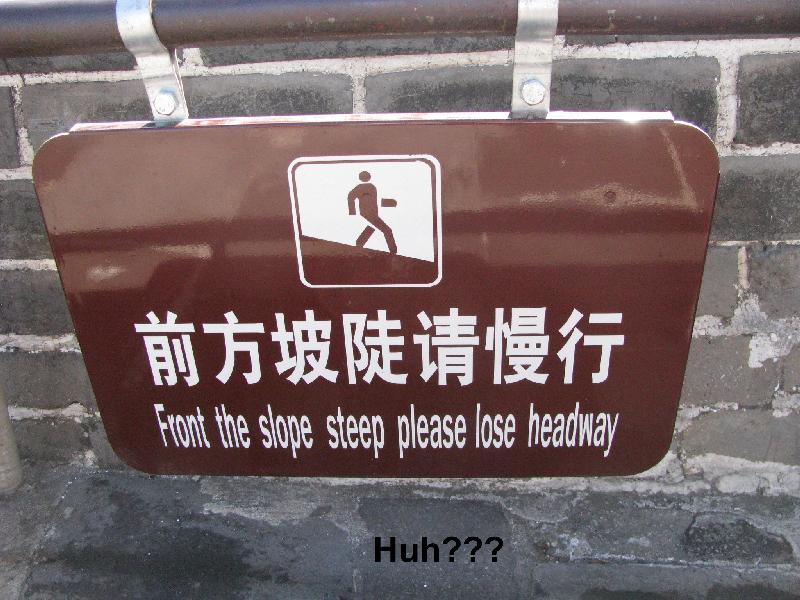
On our drive back to the city, we stopped at the Ming Tombs. The
mausoleum area is in a large park-like setting with burial mounds
and ceremonial buildings. We have learned more about the various
dynasties than one could ever hope to, but Iím afraid my retention
isnít what it used to be. Although I think there was some
de-emphasis of historic and cultural things during Maoís time. It
wouldnít appear so now.
After a stop at the jade carvers: beautiful to see, but not
something any of us needed, we drove by the Olympic village and saw
the Birdís Nest among other buildings. Unfortunately, it is not
possible for the bus to stop so we could get out. We were able to
see the athleteís housing, and other venues for the games. The
apartments were made so that walls could be knocked out between two
athleteís rooms and an apartment created. I think they were sold
before the games began. Most people in China live in apartments and
prefer to buy them.
We had a little time left so we stopped at Mr. Tís for a
traditional tea ceremony and a sampling of different types. Rick and
I got out as quickly as we could so that we could run across the
street, taking our lives in our own hands as pedestrians always do,
and got some McCafe. There are plenty of Starbucks in China for the
younger set, but it is never served with the meals we have other
than breakfast. Iím suffering from caffeine depravation!
It is immediately obvious that the Chinese are much fitter than
Americans. There traditional diet has been a rice porridge for
breakfast, a large lunch consisting mostly of vegetables and meat
sparingly and a small supper. Now there is fast food on every
corner: KFC, McDonalds, Pizza Hut. Theyíre all here and are very
popular. Within a generation, I think the Chinese will be suffering
more of the medical problems we face because of a high fat and sugar
diet. We have not seen any diet soft drinks, probably because no one
here has thought they needed them.
We had another very busy day. Elaine wears a pedometer and we are
averaging 10,000. We all thought we should be able to count double
climbing the wall!
|
|
Greeted by another beautiful day for sightseeing, we boarded the
bus for transport to the Forbidden City. Yesterday, everybody stayed
home, but not today. It is part of the 8-day October holiday and
everyone is out and about. The Forbidden City was the home of the
Emperor until the dynasty was overthrown by Sun Yat Sen in 1911, so
named since commoners were not allowed inside the walls. It is 300
or so acres comprising a complex of buildings both residential and
official, adjacent to Tianahmen Square and the plan was that we go
from one end to the other and come out at the square IF it was open.
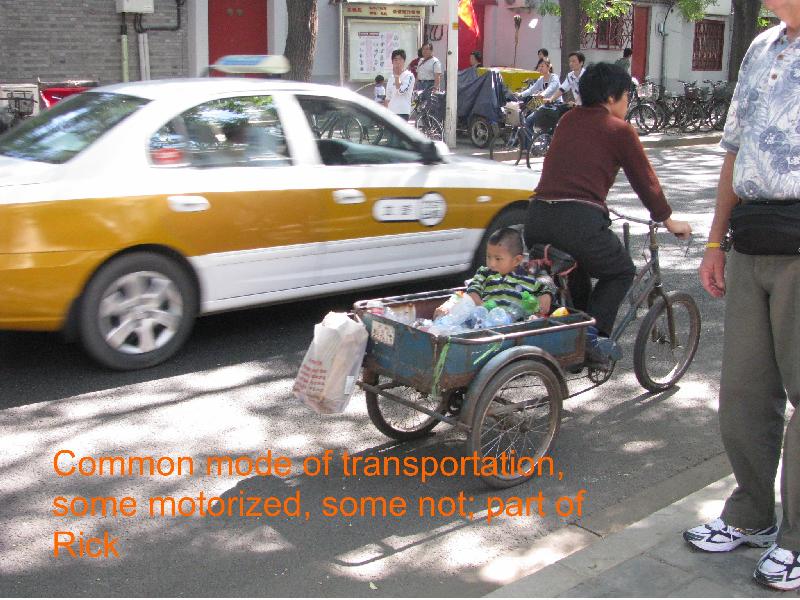
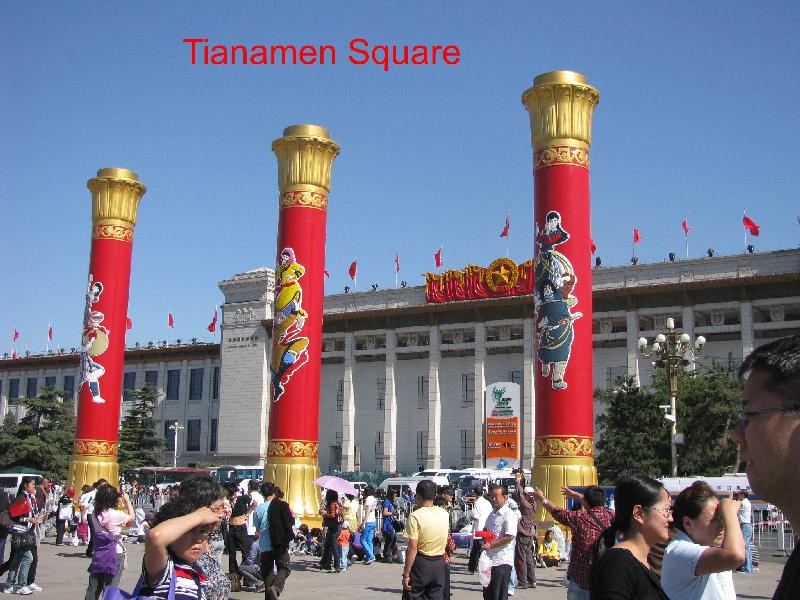
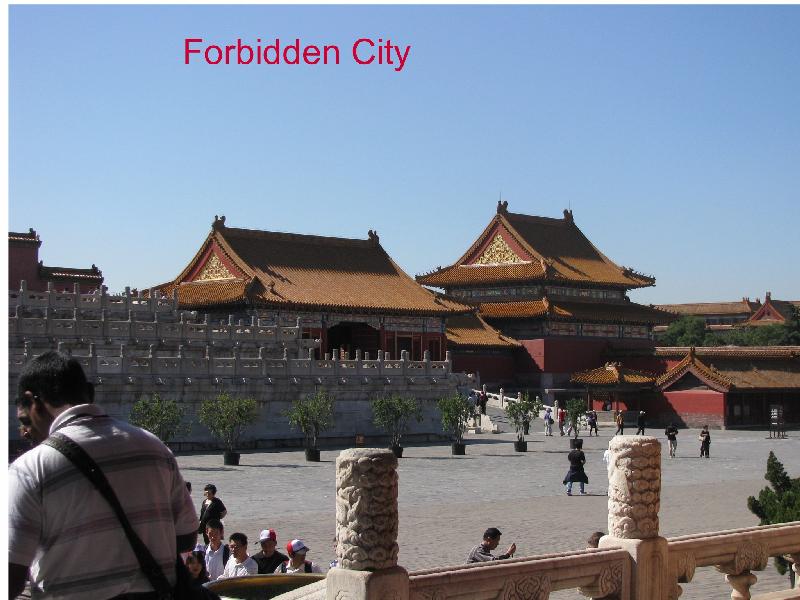
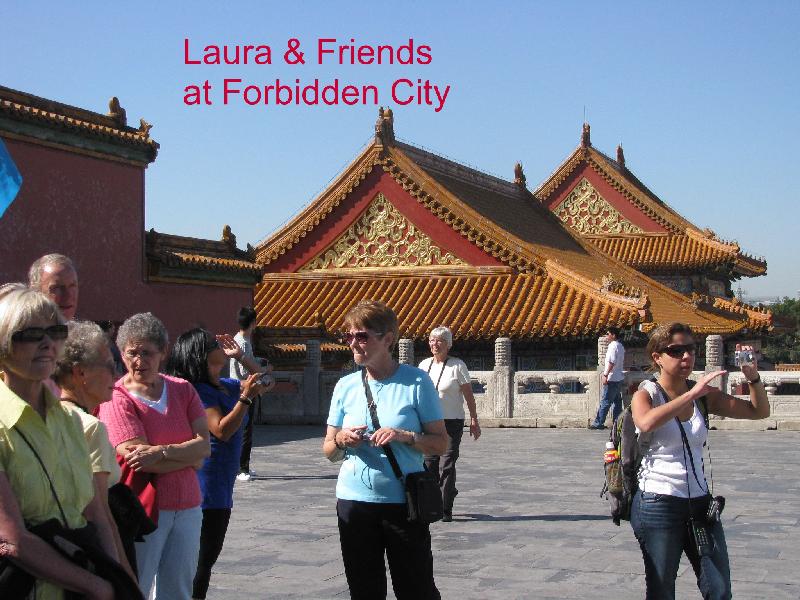
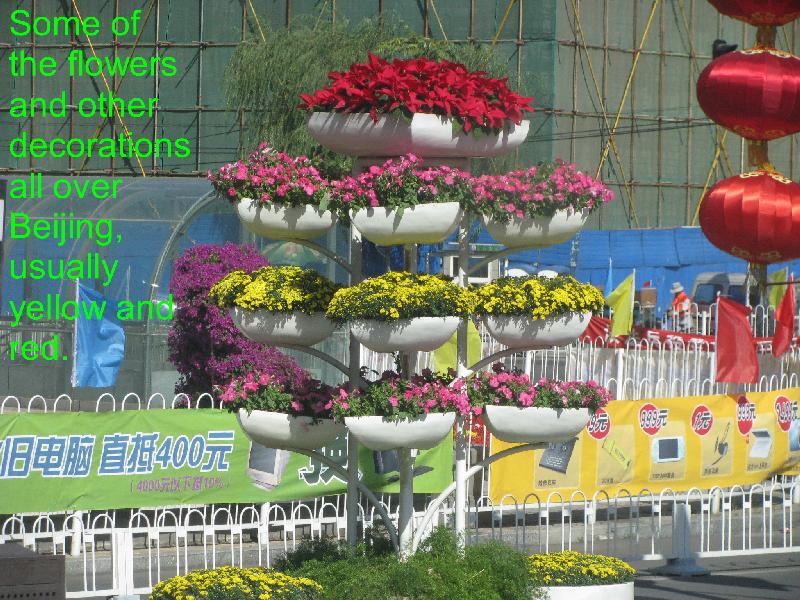
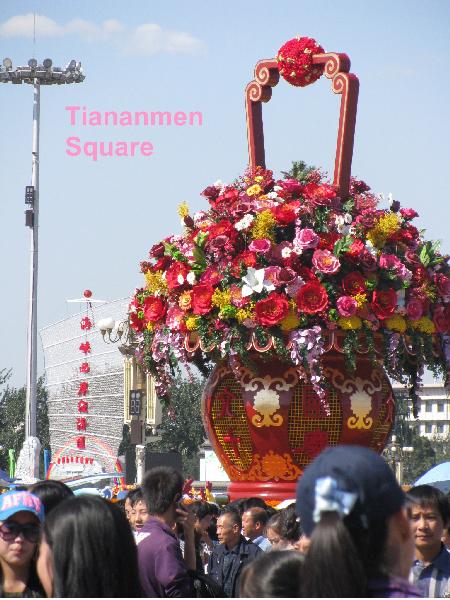
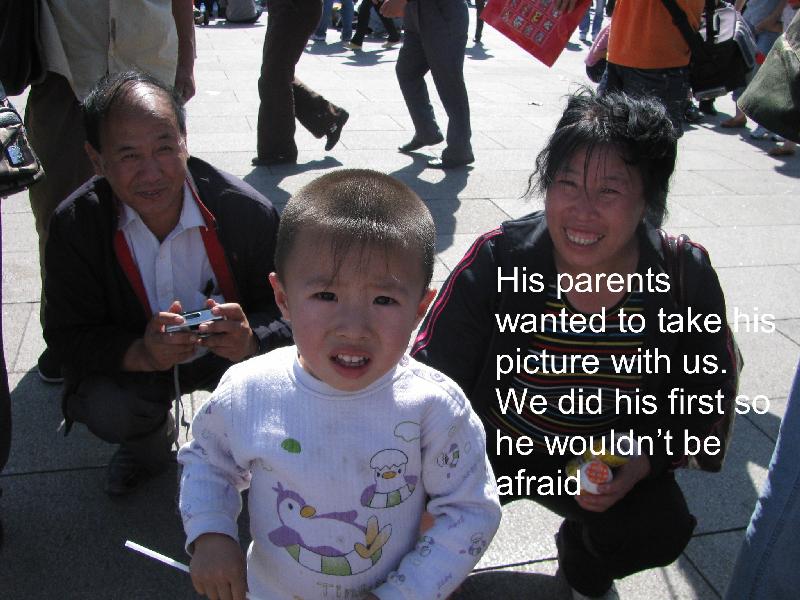
We spent a couple of hours walking through the area with our
guide helping us to understand what was the significance of the
different sections: the inner court, the outer court, and so forth.
We were told that the part facing the street was repainted and
gilded before the Olympics,since that was what would be seen from
the street. Every entry-way has a threshold about a foot high to
step over. Evil spirits canít get over it. We only later learned
that men are to use their left leg first, and women, their right.
Elaine & I decided we probably had been doing it opposite, so maybe
we cancelled out the bad luck.
We left by the south gate intending to go into Tiananmen Square
Jessica found out by cell phone that the corresponding gate was
locked. It was too far to walk to the other side so we walked down a
long street to meet our bus driver who would take us there.
Unfortunately, everyone else in China was there also, so traffic was
jammed. That street became closed and we had to walk the other
direction to finally meet up.
The square was resplendent in bright red and gold columns, huge
baskets of flowers and a 75-100 ft. t.v. screen showing pictures of
the celebrations of the day before. There had been a huge parade on
the boulevard next to the square and each province had a float. They
were lined up around the edges of the square. It was a mad house,
but at some point our guide got us in position under the smiling Mao
for a group picture, which we could get later with a book about
Beijing landmarks.
We left and after a late lunch for the airport to fly to Xiían
(she ahn)about 1 Ĺ hrs. to the southwest. It does keep one hopping
to keep up with the different airport security procedures. We
learned that we could take no liquid in our carry-ons and out
checked bags had to be locked. Fortunately, I had read about that
and had taken locks, but our guide had some just in case. If they
saw something in your checked bag, you had to go over and unlock it.
I was one and all they wanted to see was aerosol cans. We could keep
our shoes on. The luggage limit is very liberal for overseas
flights, but when you are flying within the country, they are much
stricter. Our guide thought we could help each other out if we
needed to, but it didnít seem to be necessary.
Even though our flight was short we were served a hot meal and
could watch a movie about the glorious heroes of the Second World
War. Chinese donít carry on much and board quickly. It was all us
ďbig nosesĒ as westerners are called, who bogged things down. We had
to hurry so we could eat again at about 9 p.m. We all groaned and
begged for it to be something light. No such luck. We picked at it
and felt guilty about all the starving children in America. Thatís
what Jessica grew up with and was surprised to find out later that
it wasnít true, at least to as great an extent as in China. We were
exhausted and fell into bed so we could be up and with it on yet
another tour. |
|
Xiían or Xian is two words that mean West Peace. It is a fertile
area in the center of China which was the home of the early
dynasties, the Qin dynasty of over 2,000 years ago which unified
China. There is abundant agriculture and the area is noted for its
pomegranates, persimmons, apples and pears. The pomegranates are
ripe and on the trees each one was enclosed with plastic bags. They
are huge here and whitish in color. They eat them seeds and all,
leading they think to the birth of a boy. We saw numerous roadside
stands to attract the hordes of vacationers.
In the mid-70ís there was a severe draught, causing farmers to
dig wells for water. Several of them ended up unearthing pieces of
the 8th wonder of the ancient world, the terra cotta warriors. The
farmers were terrified by what portended bad luck. Thatís not the
way it turned out. Xiían is an industrial city of 6 million and
before this find, there wasnít much reason for tourists to visit.
What the farmers found was 6 thousand life-sized warriors which had
largely been broken up due to wars and fires that caused the roofs
to fall in. Since that time 3 huge pits have been opened and
buildings constructed over the top of them.
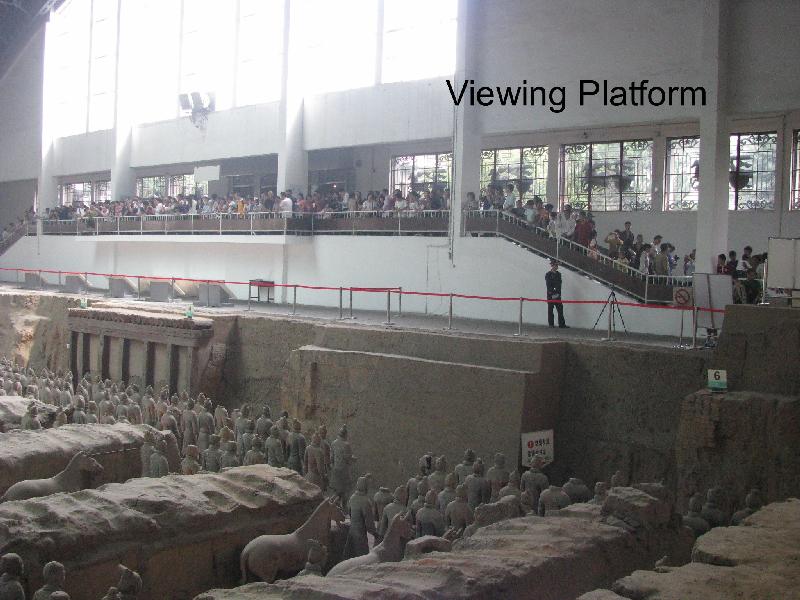
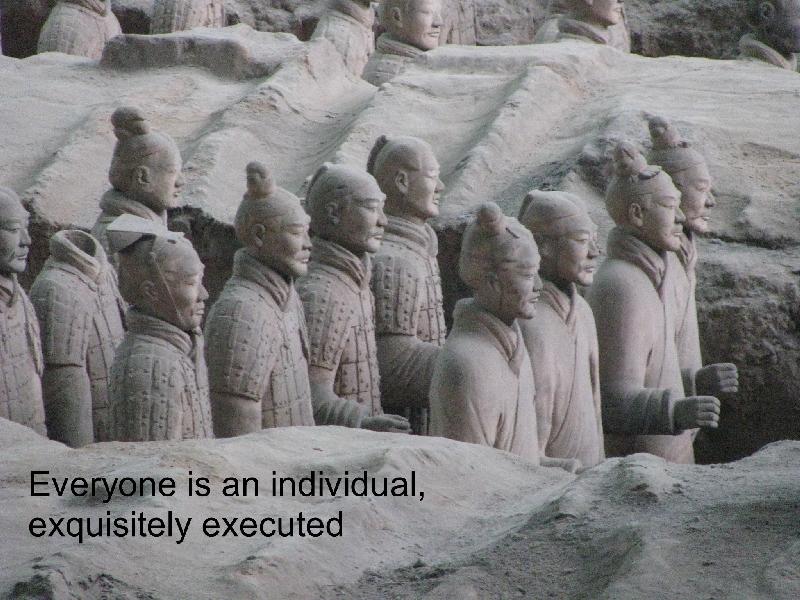
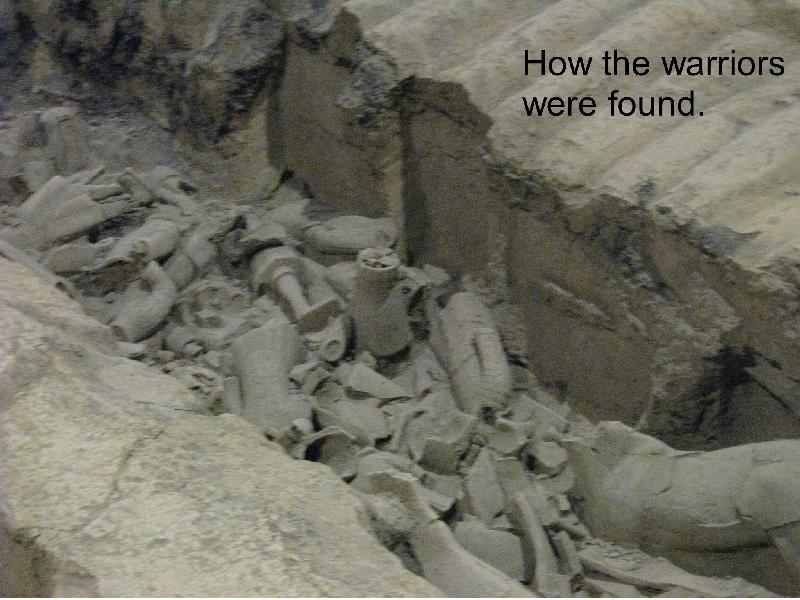
The most remarkable thing about these figures is that they are
all life-sized many nearly 6 feet tall with personalized faces that
donít look much different from the people who live here 2000 years
later. The other two pits are smaller and represent different
aspects of life at that time. Yet another building houses a Ĺ sized
bronze chariot with 4 horses. It is possible that somewhere in the
area are buried more bronze warriors. Much of the area is yet to be
excavated including the emperorís tomb. There is concern that
disturbing it would lead to its disintegration. The terra cotta
warriors were originally in full color, and whatever color was there
when the excavations occurred has faded. It is about a Ĺ mile walk
into the museum from the parking lot and then there is a lot of
walking around the area so we had no trouble getting our 10,000
steps in yet again.
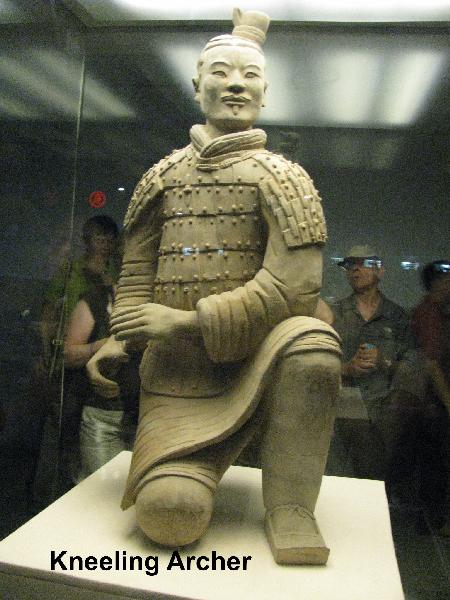
On the way back, we stopped at a museum of folk and fine Chinese
art. We had a great guide and I especially enjoyed the very colorful
folk paints of the farmer painters. I know lots of farmers, and most
of them never had much time for hobbies such as that, so I asked how
that came about. She said that during the Cultural Revolution the
artists and scholars were ordered to leave the cities and go to the
countryside to learn how real work was done, to get them closer to
the people. While they were there, they shared their talents and
locals took up the hobby. Now days they have become very famous and
earn money. Many of our group bought watercolors to bring home and
frame.
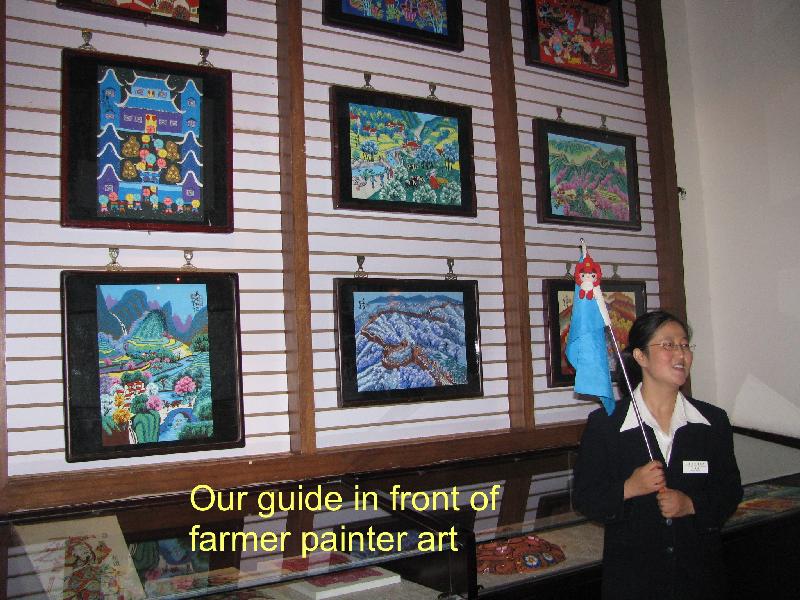
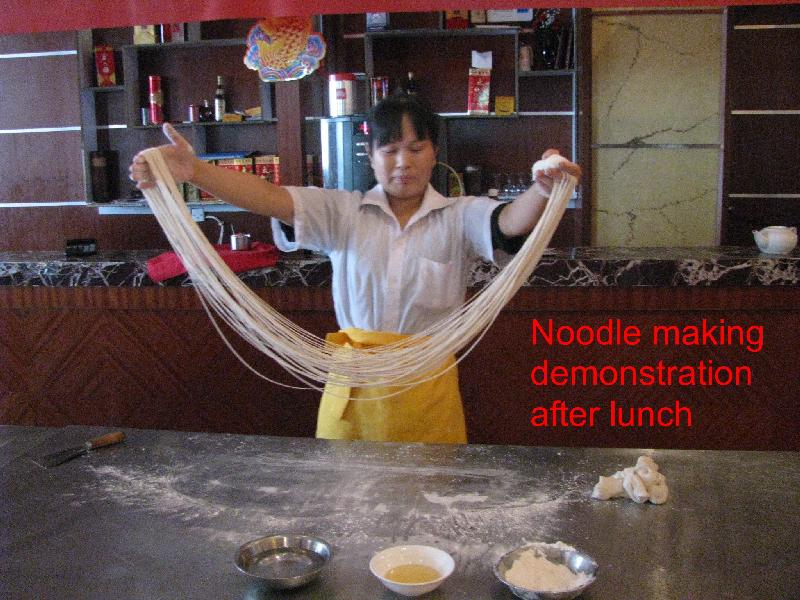
It was back to the hotel to get ready to go out for dinner
theatre. We went to a large concert hall set up with tables holding
hundreds. After we ate, there was an elaborate production much like
it would have been in the Tong Dynasty. There were beautiful
costumes, sets, singing and traditional instruments. To make it a
little more palatable to western ears, and we were mostly western,
the music was more tonal than it would have been in earlier times.
It lasted about an hour. Iím not sure we appreciated it as we should
since we were pretty tired by this time.
Several of us have been suffering from the dreaded ďdĒ condition
no matter how careful we try to be. We were told on the first day
not to drink the water in the hotels, not even to use it to brush
your teeth. We are always provided bottled water and can buy more
cheaply. We can drink soft drinks, beer, coffee, tea and
occasionally wine, but the choices and amounts are limited for
American tastes. I have not seen an ice cube, and thatís probably a
good thing. Our guides and tour company work hard to choose
restaurants that meet certain standards to keep the food safe. This
is true most anywhere in the world, itís just that weíre not used to
the same germs. Fortunately we were warned to bring proper
medications to nip anything in the bud.
|
|
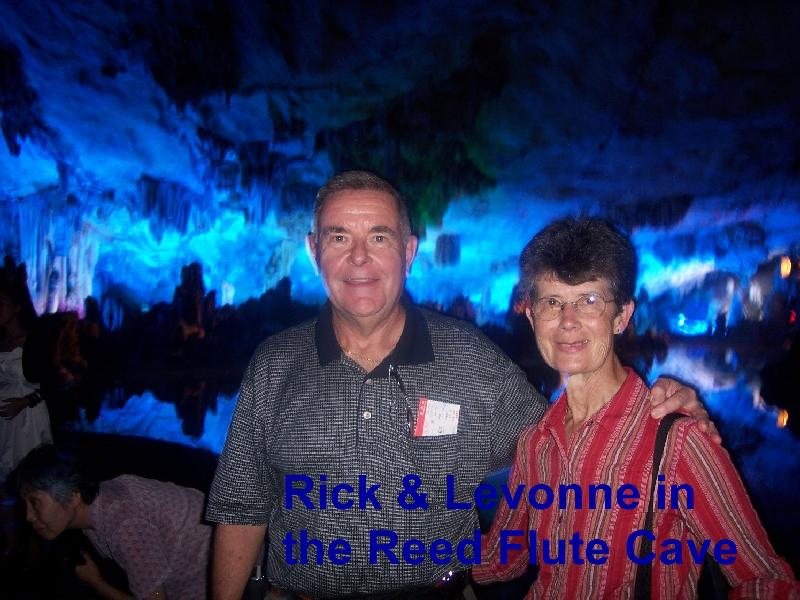
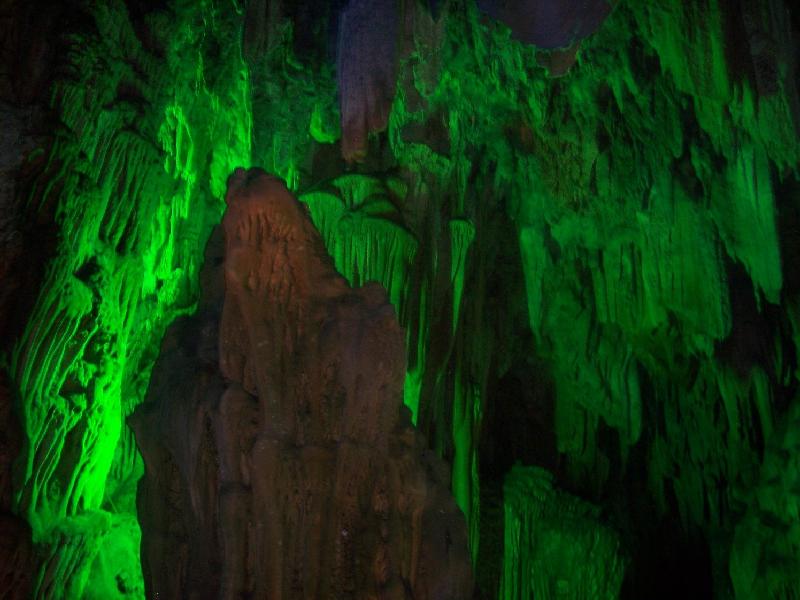
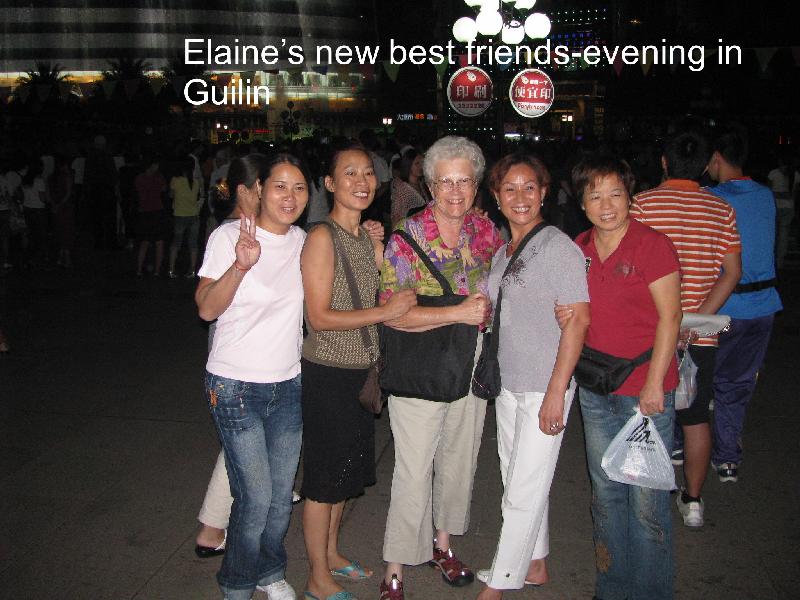
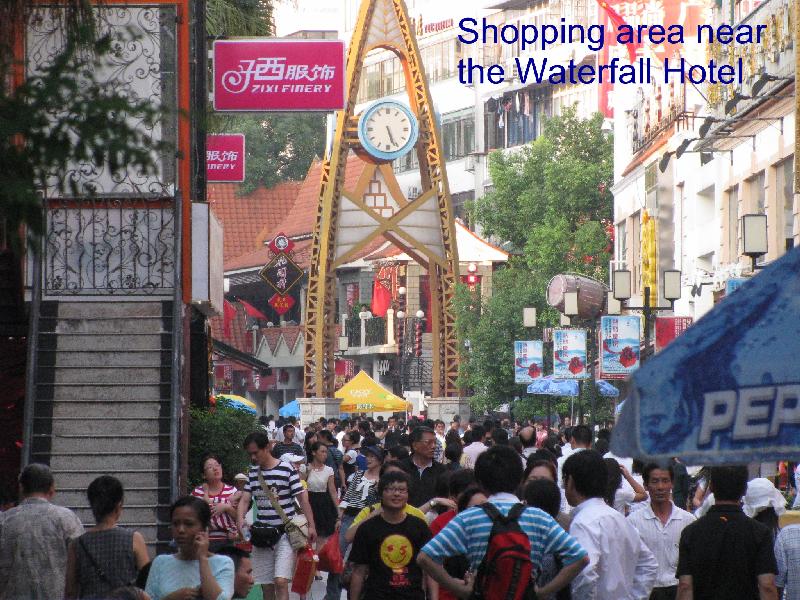
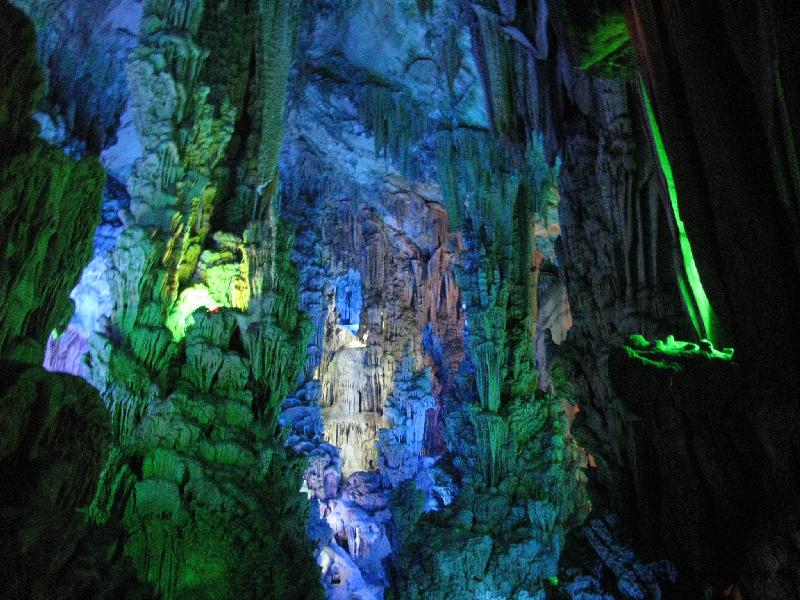
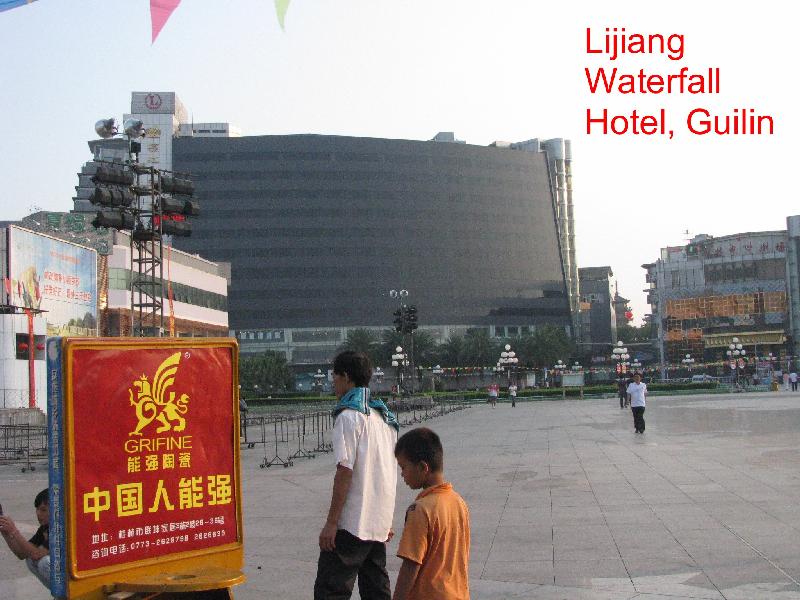
Another flight, but before we left for the airport, we went to
the Xiían city wall, one of the only ones left largely intact in
China. Originally it was made of dirt dug out to make the moat. Over
the years, brick was added and eventually it was faced with stone.
We entered through a museum showing some archeological digging
showing the original wall. Then up a couple of flights of stairs, we
found ourselves on top of the wall which is about 50 feet wide and
paved. One could ride bicycles, walk or jog around the entire city,
about 6 miles.
Just inside the wall near where we were, was an open air market
selling produce and a variety of items. Most had been brought by
some sort of three-wheeled conveyance, some motorized and some not.
They have small beds like a pickup. There were beautiful fruits and
vegetables. One lady was rolling out dough, putting in a filling,
folding it in half and cooking it on a makeshift grill. We had a
great vantage point to observe all the comings and goings. Our guide
said she shopped for fresh food to cook everyday and it was much
better. As we were about to leave (9:30), the market folded up and
everyone left.
Then itís off to the airport for about a 1 Ĺ hr. flight to the
small city (so it was described, but has 600,000 people) of Guilin (Gwee
Linn). It is in the sub-tropical South China at a fairly low
elevation surrounded by limestone mountains that have been eroded
away to leave pinnacles and cones. They are a very beautiful green
with limestone showing through.
We are now in rice country and there are rice paddies everywhere
on every scrap of land. The plots are small and much of the work is
done by hand. For harvest, the rice is cut with a sickle and then
fed into a machine to separate the grain. Also, there are citrus
crops, huge grapefruit and other crops such as you would find in
Southern California.
From the airport, we drove to the Reed Flute Cave. If was
discovered in the 1950ís and has been made very accessible with
paved paths and steps. The lighting is very imaginative,
highlighting the various formations. Mid-way there is a large room
which can hold several hundred people. A sound and light program
plays frequently with lasers bouncing from place to place. A
reflecting pool shows what looks like the Manhattan skyline and in
the reflection, a sky slope.
From there, we were taken to our hotel, truly the most unique of
our trip: the Lijuan Waterfall Hotel. We had a few minutes to settle
into our room before it was off to dinner. As with most lunches and
dinners, it was at 2 round tables of about 10 each with a glass
lazy-susan in the middle. In front of us is a small plate, a bowl
for soup with a china spoon and chop sticks. Forks are always
available. To drink we have the choice of Sprite, Coke, beer or
water. They may be chilled. We are usually told that one glass is
complimentary. Then the dishes start coming out. I think Chinese
would always use their chop sticks to take food from the serving
plates, but they usually bring forks or large spoons for us. What
they call fried rice is usually white with a few vegetables like
carrots and peas mixed in. We have almost never seen soya sauce. The
dishes will include pork, beef, chicken, fish, various kinds of
mushrooms, baby bok choy, spinach, egg plant and sprouts. There will
be some kind of soup and weíll know we are nearing the end when the
watermelon is served. I think our guides have done a good job of
selecting dishes they think westerners would most enjoy. As we
travel more south the food gets hotter.
After dinner we just had time to go outside to see the once a day
water spectacular. Fountains start up and then water begins to come
pouring off the roof engulfing the entire side of the 12 story
building in a waterfall. Our room faces this side of the building
and if we were inside, we would see water pouring past the window.
It lasts about 10 minutes with music playing and crowds watching. We
were told that once some Swedes were visiting and the regular time
of the show didnít coincide with their schedule, so could they have
it go off at another time. Yes they could for 5000 yuan ($750). No
problem and everyone was treated to another waterfall.
|
|
One of the most picturesque areas of China is the Li River, a
destination for many Chinese and foreigners. A typical tour is to
drive about an hour from Guilin and board a boat for a 4 hour cruise
up through the Dragonís Teeth, the unusual limestone rock
formations. We boarded and joined a steady stream of boats. It was
perfect weather to go up top and view the spectacular scenery. We
could watch the fishermen in their small boats, many that looked
like about 6 large bamboo stalks lashed together. Some had chairs
for tourists that one could hire.
Mountain climbing and hiking are popular and we could see
encampments both organized and unorganized along the way.
Occasionally we would see the fisherman come up and tie onto a large
boat and sell some kind of fish or shellfish. Others would be
bringing souvenirs and hold them up to our windows, but they werenít
allowed to board.
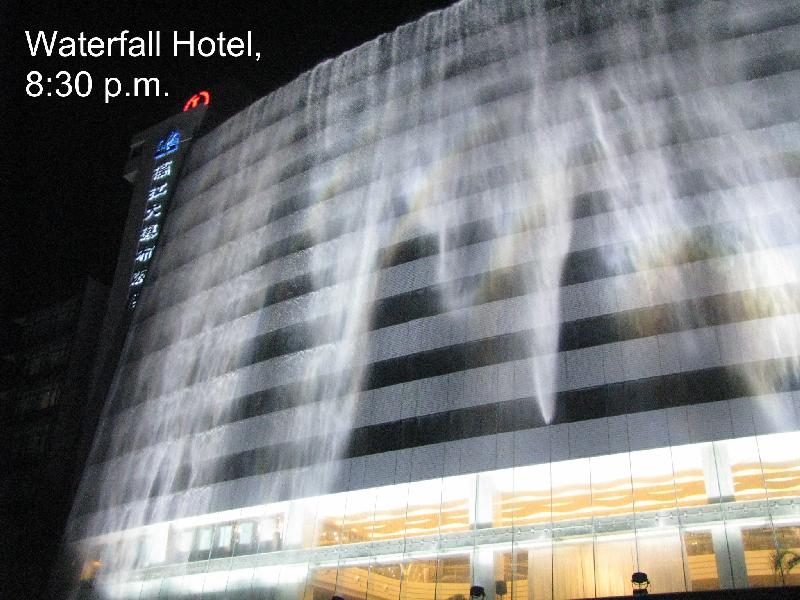
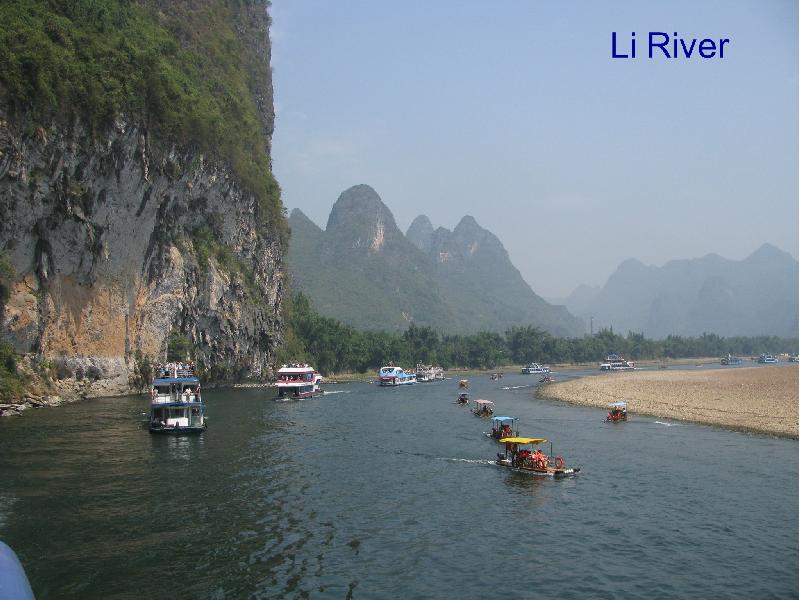
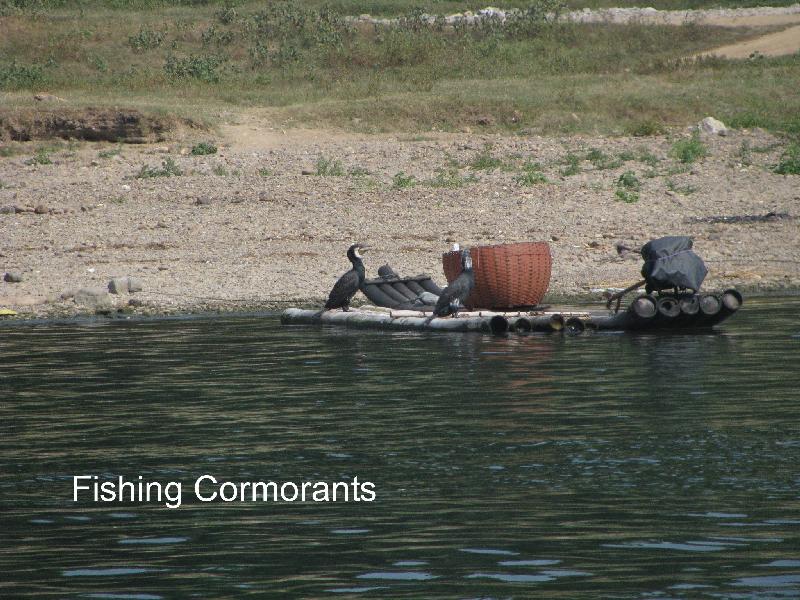
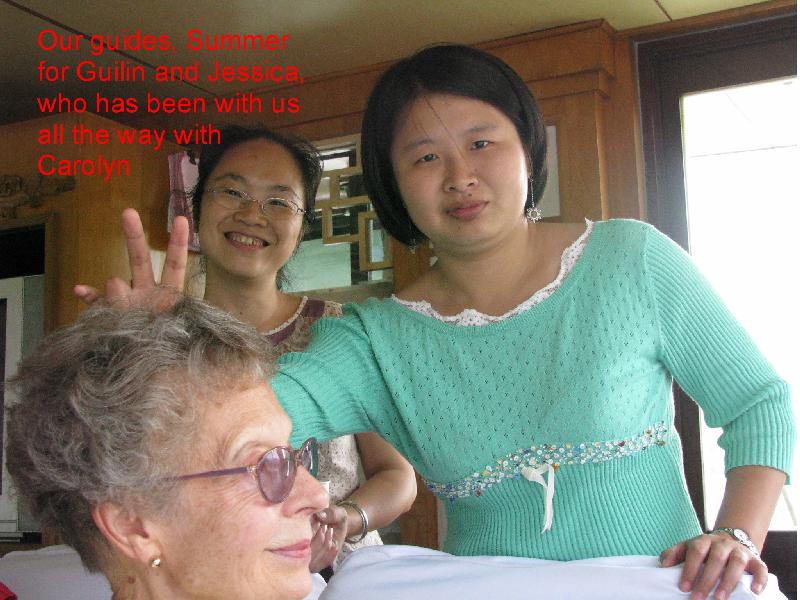
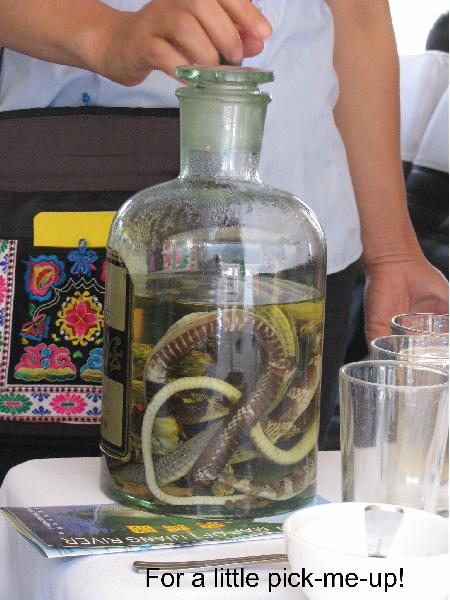
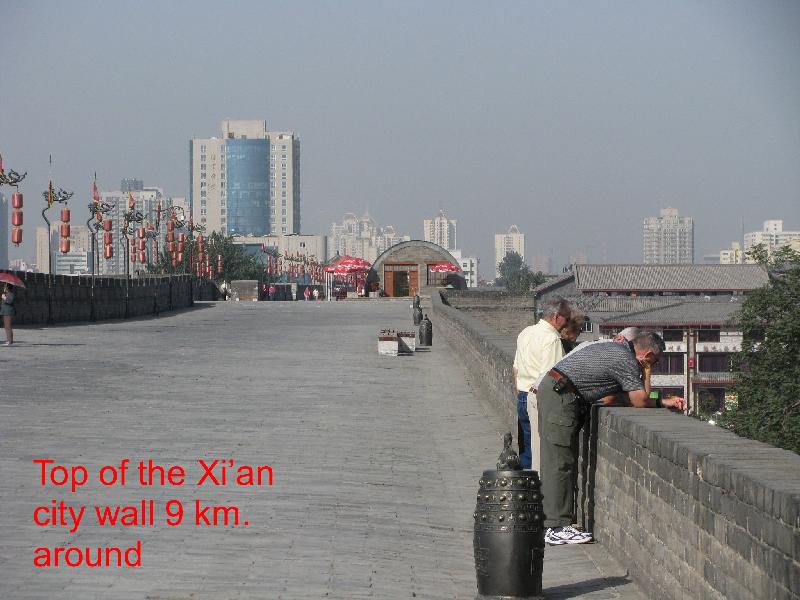
On the back of each of the boats we could see the cooks with big
woks preparing meals for all their passengers. Our guides had chosen
one of the few boats that met their standards, and they had hired
their own cook and waitress to serve our western dinner: a seafood
salad, steak, potatoes and ďbackedĒ cheese cake for dessert. Behind
us the Chinese were having a more traditional dinner and loudly
playing cards. We chuckled about how we had heard that the Chinese
were getting used to the loud Americans. You havenít heard loud
untilÖ.. We were invited to buy extra drinks, including some kind of
hard drink that had snakes floating around it and some deep fried
foods like small crabs and scorpions. We all declined.
The river looked very clean and not too deep. One could see the
rocks on the bottom and people were swimming. There were cattle and
lots of water buffalo belonging to farmers along the way. Most of
the time, we couldnít see the farms behind the dykes or trees. There
were lots of birds and just before our cruise ended, we saw
cormorants trained to fish. Their necks are constricted so that they
donít swallow the fish so it can be retrieved by the fisherman. They
will go underwater for a minute or so and come up with a good-sized
fish.
After we disembarked at a small town upriver, we boarded the bus
for a 1 Ĺ hour bus ride back to the hotel through an agricultural
area that was fun to see, lots of rice and many vegetable and
fruits. I would have liked to have toured a farm (s), but that
wasnít on our itinerary. After a stop at the South China Pearl
Factory for those interested, we were back in the hotel. We walked
through a very interesting shopping are and bought some coffee
before going to our room to get ready to go out for dinner. Some got
foot massages, but by then bed was mighty inviting.
|
|
We
were up at the crack of dawn to get our suitcases out for a 1 hour
flight to the largest city in China, ChongQing, 30,000,000. If I
understood correctly, Shanghai is the largest city proper, but
ChongQing is a province/city. Very major cities are directly under
the authority of the central government, the rest are administered
by the province. ChongQing was the wartime capital of China more
familiar to us as Chung King.
ChongQing is a very hilly city and porters are everywhere to
carry stuff up the hills. The streets, if they exist, are too small
for delivery vans, so men carry everything: new furniture, a
refrigerator, you name it. Rod noticed that the people had large
calves from walking up so many steps all the time.
Our first destination was the zoo to see the pandas. They obliged
and came out to munch on their principal diet of bamboo. We elected
not to spend much time there since a zoo is a zoo and were taken to
a new city square housing the Yangtze Museum, a beautiful four story
building with an open domed interior of marble that looks like
carved ivory. There were some interesting exhibits, but not enough
English descriptions to satisfy us. There was an excellent display
of artifacts unearthed in the building of the Three Gorges Dam, the
largest construction project in the world.
We walked across the square down a side street and were taken to
a large public market. It had every food item imaginable, very fresh
looking and people buying their daily provisions. Our guide had
mentioned that she wouldnít tell us what she had for lunch for a
couple hours. I assumed she thought we would find it revolting.
Later she said it was frog. We said we liked frogís legs and in the
market we saw them. When someone wanted one, the man grabbed a live
one from under a net and dispatched it into small pieces with a
cleaver and bagged it up for the buyer. The next table was cleaning
an eel. Someone else whacked a large fish. Later in the trip we were
served a large fish that was turned inside out, cut part way through
into French fry-sized pieces still attached, breaded and fried. It
was very good. The people didnít seem to mind us taking pictures and
probably knew we werenít going to buy anything.
Our guides had been promising a regional specialty for dinner and
we were taken out for ďhot potĒ. In the center of a square table for
eight were two large metal bowls, one inside the other, on a gas
burner. It was broth, one very spicy, the other not. All around were
small dishes of items to put in the hot pot to cook. It was a
communal effort, and we just needed to wait long enough to be sure
the item was cooked. One uses chop sticks or a large slotted spoon
to retrieve the cooked food. We were told that we should stick our
chop sticks into the boiling broth to sterilize them if they were
used to put in raw meat. There was thinly sliced beef, pork meat
balls, black fungi, seaweed, tofu, chicken, noodles of several
varieties, etc. The hot wasnít overpowering and gave a nice
flavoring. We had small bowls and put in sesame oil, soya sauce &
vinegar to dip the cooked food into. Our guides had to table hop to
keep us all going. The hot pot originated in Mongolia and in some
ways it reminded me of the Mongolian Grill.
We were then taken to the port to begin a 4 day cruise down the
Yangtze. After we got settled in our cabins, we went upstairs in the
balmy air to look at the spectacular lighted cityscape. In the
1980ís there were no bridges across the Yangtze and now there are 31
of every type. The one nearest the boat was similar to the Fremont
Bridge in Portland, only larger and beautifully lighted. The sky
scrapers, all only a few years old, were brightly lit. Across the
river was the opera house and there was a huge tv projection on its
side probably 50 x 100 ft. Some call this city the Hong Kong of the
mainland. We sailed at 10 p.m. and were glad to fall into our narrow
twin beds, but easing in was wiser, as we might have broken bones on
the hard surface. (Not to complain.)
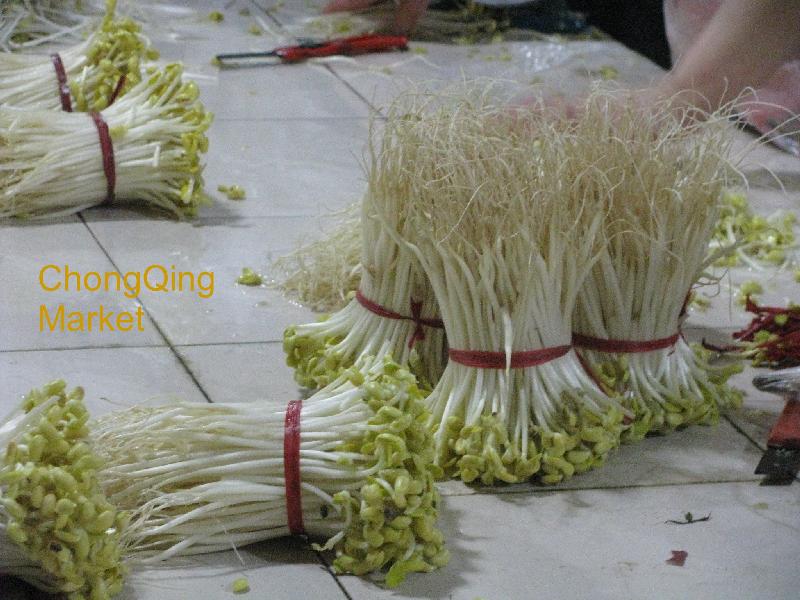
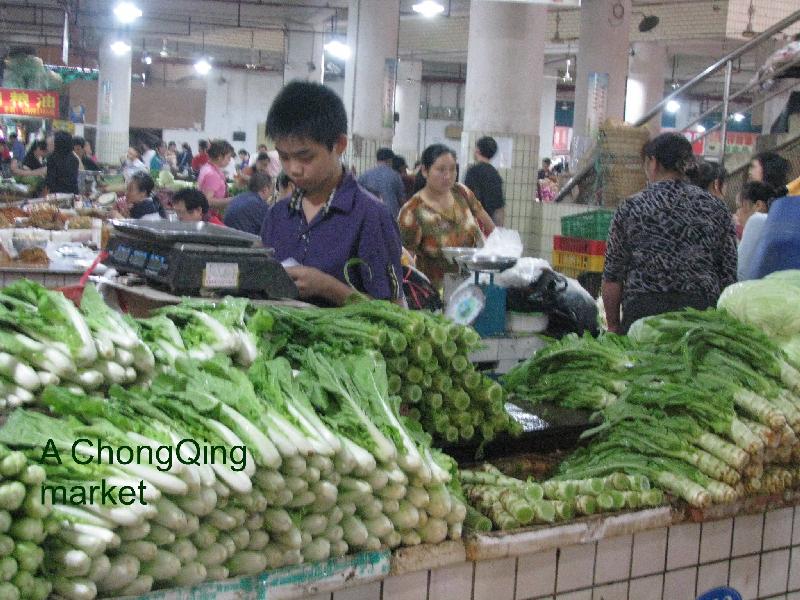
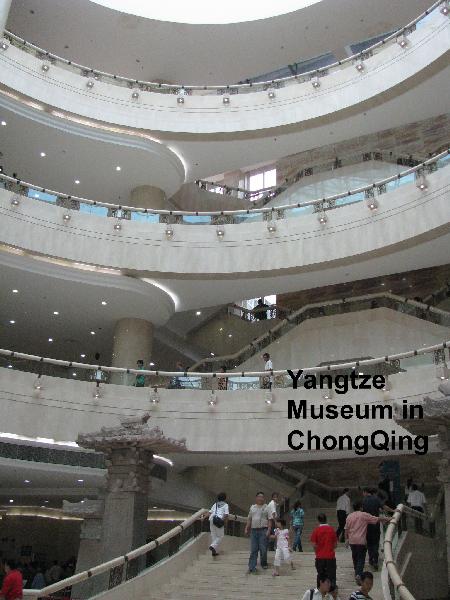
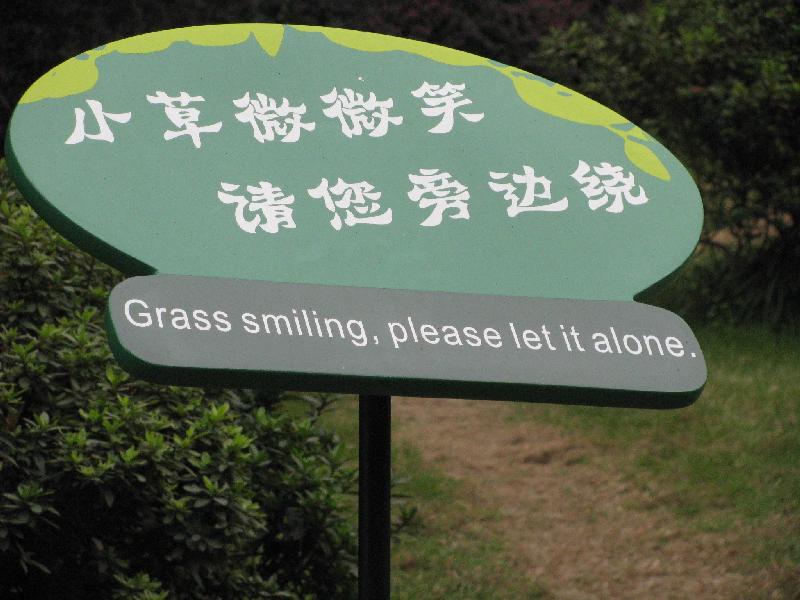
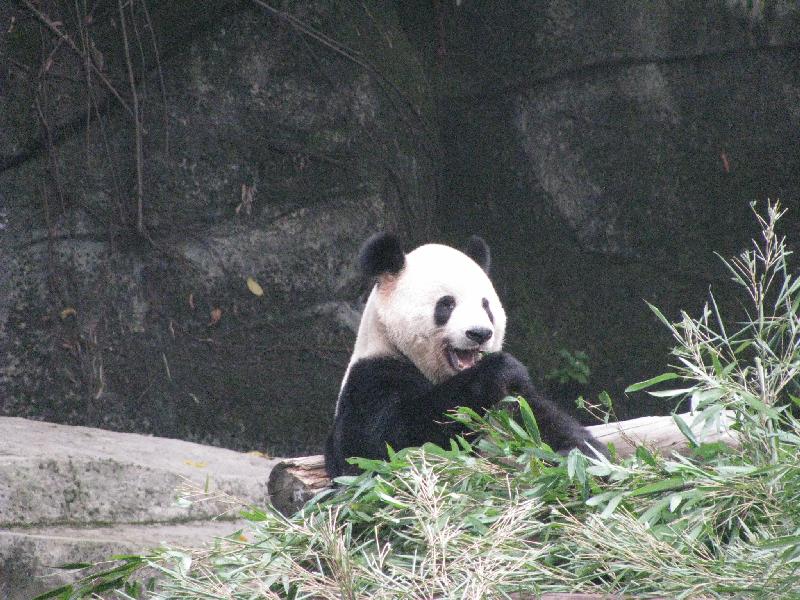

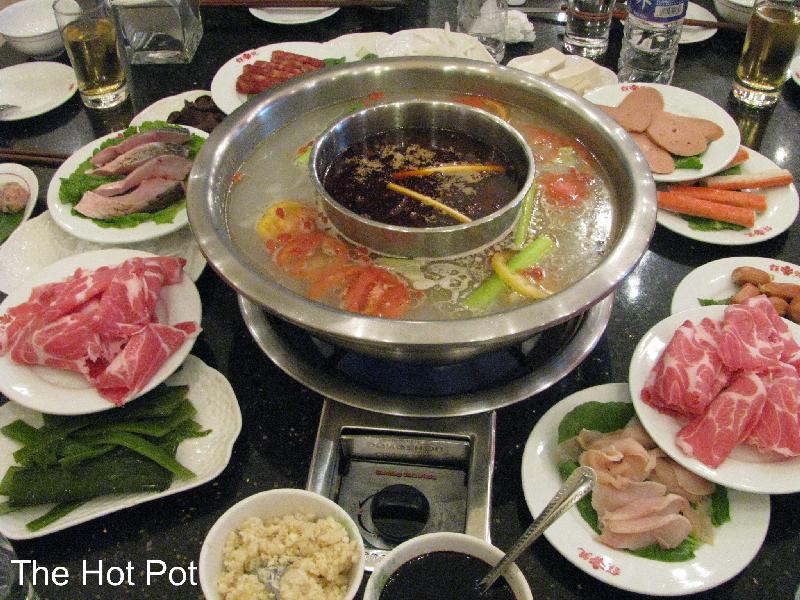
|
|
Cheerful music through the loudspeaker announcing breakfast woke
up any lay-a-beds. We are assigned tables for our meals and
breakfast and lunch are buffet. The first evening meal was the
Captainís dinner with introductions and a toast at each table. The
English were all dressed up, of course; we managed long pants and a
shirt. Our two tables were toasted first, and we managed a major
/faux pas/ by not standing up. Our guide was late, and when we told
her, she said she was glad she wasnít there because it might have
reflected badly on her. She was kidding, I think.
After dinner we went to the ballroom to see a show put on by the
crew. They were cute in their colorful costumes. One man sang a
spirited rendition of ďEdelweissĒ with scenes from the /Sound of
Music/ playing behind him. After a flamenco number and a precision
drill of all the staff, we left.
The girls have been enjoying the craft demonstrations given by
artists. I can only tell of them second-hand, but even I am
impressed by the skill and beauty. One man comes from a family that
takes quartz, cuts and polishes pieces and drills out the center to
make a bottle. Then he takes a brush and paints a picture on the
inside. They are very beautiful and colorfulóreasonable for all the
hours of work. Of course we get a special discount.
Another craft is silk embroidery. They will take a strand of silk
thread and separate it into 30 strands. The delicate stitchery makes
pictures that can be viewed from each side. One large one on display
has tigers on one side and when flipped, shows leopards.
The second day we are going through the first and second of the 3
gorges, something like the Columbia River gorge. The new dam is
largely completed and we can only imagine what it must have been
like. Now it has only about 30 feet more to go before it is
completely filled. The walls are sheer cliffs, but wherever it
flattens out a little, there are farms terraced. We passed two
farms, and the guide said that the farmers would only get into town
once or twice a year. There would only be trails to get in or out.
Iím sure it gets windy, but probably not too cold since we are at
low latitude.
As Iím writing this, Iím sitting by the balcony door looking at
the cliffs that remind me of Multnomah Falls. The only falls we have
seen here is on the side of the hotel. The weather is cool and
somewhat foggy which hampers the picture taking. The river started
out very muddy, but has become more green. We see many ferries often
hydrofoils and various watercraft. It is a busy river.
This afternoon we were treated to a sampan ride up the Shennongxi
stream, a tributary of the Yangtze. For the first hour we were on a
ferry to get to the boatmen. The boats each held 16 people and there
were 5 boat trackers, 2 captains and 3 rowers. We were rowed for 2
miles upstream, then the last few hundred yards 2 men jumped off and
demonstrated pulling us by a bamboo rope on a foot path. Before the
tourists came, the boatmen would have been nude, since the stream
was shallow and they pulled the boats up the free-flowing stream by
walking on the rocks. Their cotton clothes got wet and chaffed their
skin. Not to offend or titillate the tourists, they now wear clothes
and since the Three Gorges Dam, the water in the stream is 450 ft.
deep or so instead of 1 to 3 ft. before. The scenery was very
beautiful and we saw people fishing, some terraced farms and sheer
rock walls. At one place there is a ďhanging coffinĒ placed by
ancient people. Apparently the idea was that to bring more blessings
to your family, you should place the coffin of your father high up
the cliff. No one knows how they got them there. At one point we saw
a new suspension foot bridge built after the dam. To go around might
take 5 hours to get to the village. The ethnic minority living in
this area, of whom our guide and the boatmen belonged, is healthy
and strong from lots of exercise.
Yesterday morning we stopped at a shrine called the City of
Ghosts. There were about 1000 steps up the hillside, but we could
take cable cars like a ski lift up part of the way. At the top were
numerous temples of various gods, but particularly representing
Hell. The King of Hell is a just God who will determine whether one
should be punished or not, so you should bow before him. On the
sides were small statues representing what happens to the wayward.
The bigamist is being sawn in half lengthways, one for each wife,
for instance. Our guide had us laugh loudly as we passed under a
particular arch; another time we needed to stand in a concrete
enclosure on one foot with hands together. Since there were so many
people, Rick represented our group. Another place, there was a heavy
iron object that needed to be lifted atop and balanced on a stand.
Many tried, but only the expert knew how to twirl it around and use
the momentum to get it atop.
Our last day shipboard, we made an early morning stop to see the
Three Gorges Dam project. Last night beginning about 10:30 we went
through the 5 locks to get to the lower river. It is the largest set
of locks in the world with gates for traffic in both directions. I
went to bed as they were maneuvering the last of 4 boats in place to
shut the gates. The construction has been going for 17 years and all
that is left is a ship elevator, designed for smaller boats.
Everything else, the locks, generators, etc. was completed ahead of
schedule, but the elevator is taking more time for engineering.
Our whole time on the Yangtze (called Jiang by the Chinese) has
been quite foggy all during the three days. While we were at the
dam, the guide pulled out a picture that was about 12 feet long that
was aerial photos of the river from ChongQing to Yichang, about 300
miles in length. It took 10 years to get the picture taken because
it is foggy over 300 days a year. We questioned whether it was some
degree smog, but didnít have an answer.
The Chinese seem to be very proud of the dam and feel it is
progress. It was first proposed by Dr. Sun Yat Sen over 100 years
ago mainly for flood control ameliorating the ravages of period
floods. We are also sympathetic to the plight of the million plus
people who have been displaced by the project. Our guide says that
compensation was available with help for re-location and jobs. It is
hard if your family has lived on the land for generations.
|
|
After visiting the dam and having a final lunch on the boat, it was
time to leave for the airport. We docked at Yichang. We had our
carry-ons to tote up the 100 steps from the river; our luggage was
taken by porters with a pole and ropes at a run. One way they would
be carrying 2 large water jugs, and on the way back, they had about
4 suitcases. It was amazing to watching them balance their load
going down and up the stairs with ease. For our convenience, we gave
our guide money at the beginning to tip all the baggage handlers, so
we didnít have to give it any thought as we progressed throughout
the trip.
Yichang is a very small regional airport and the flight was about
1 hour to the old airport in Shanghai. We had the most unusual box
to snack on: a package of tiny dried plums about the size of a
filbert which were thrown after one taste, candied walnuts, a dry
roll, a small cupcake, and cough drops. Even at that, it beat
anything we would get on an airline at home. It was ok, since we
knew we would be stopping for dinner on the way to the hotel, a
Schezwan chain which was very good. It was Levonneís birthday, in
Asia, at least, and Jessica had ordered a cake. We sang in English
and Chinese.
Our hotel, the Garden Hotel, is Japanese complete with a Toto
Washlet in the bathroom. I believe lots of Japanese were staying
there since there was a lot of bowing in the elevator and elsewhere.
Jessica said that Chinese donít kowtow anymore and her friend was a
guide to a Japanese group and her back hurt from all that bowing.
The breakfast was Chinese, Japanese and Western.
It is amazing what Shanghai has accomplished in the last 20
years. There are tall buildings everywhere including the tallest in
China at 101 stories. Shanghai is a relative new city, which earlier
in the 19th century was divided up with zones for the English,
French, American and German interests. The housing that remains from
that era has a European flavor.
We left the hotel early to go to the Yu Garden, a traditional
Chinese garden built for a private aristocratic family about 400
years ago. It was built in the traditional style by a painter using
rock, water, and plants. At various places there is an opening that
frames some of the landscape making it look like a painting. The
pathways zigzag so that one sees a difference view at each step.
Although in the middle of the city, it was calm and peaceful. Just
outside was an interesting shopping area where the ladies found some
costume jewelry and cut paper designs for framing. Several of the
gentlemen found the Starbucks. The owner seemed quite pleased when
we said it was just exactly like one we would find in America. I
donít know how well they do since Chinese donít seem to drink much
coffee and itís only offered at breakfast.
Our next stop was the Shanghai museum. We especially enjoyed the
exhibits of pottery, porcelain, paining and jade. We had about an
hour and a half to stroll around at our own pace. When we met up
with our guide we were taken to lunch at a silk factory. Although
the food was good, it seemed to be mostly set up for the tourists.
We got to see how silk is retrieved from the cocoons and either
spun, or pulled out to make batting for comforters similar to
down-filled. We had never seen those before and they were tempting;
about the same price as down. Out Toronto friends brought several,
but in general our group arenít big spenders at the shopping areas.
In the afternoon, we traveled to the other side of the river near
a huge radio tower. We could look across and see the Bund which was
the area of European-style buildings from the last century: large
banks, etc. After a short stop at the Nanjing (Nanking) Road
shopping area with pedestrian streets, it was back to the hotel to
get ready for the Farewell Dinner and an acrobatic performance. The
latter was in a theatre just across the street from our hotel and
was a great 1 Ĺ hour demonstration of athletic, dramatic and comedic
skills. We all thoroughly enjoyed it. We have been down to 16 in
Shanghai since 4 of our Toronto friends left the group to travel
home in time for Canada Thanksgiving and work. Our tour is flexible
and different participants have deviated at times from the
itinerary.
Today, Sunday, we are at the airport getting ready for a flight
to Hong Kong. We have bid adieu to everyone in our group, except Rod
& Pat, Rick & Levonne and Elaine & I. We have said goodbye to our
wonderful tour guide, Jessica and our in the International Terminal
of the New Shanghai Airport. We were taken to the Maglev Station
(magnetic elevated) this morning to ride the maglev train. It is
about 20 miles away and it took 7 minutes at speeds exceeding 440
km/hr, 300 mph. This is one of the nicest airports weíve seen
anywhere, well laid out and comfortable for our several hour wait. I
think it was built on reclaimed land in the Yangtze Delta.
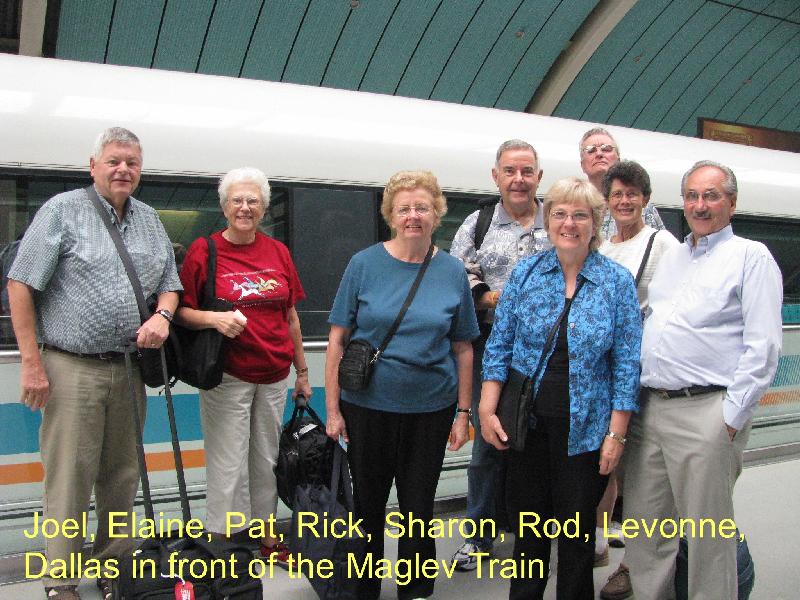
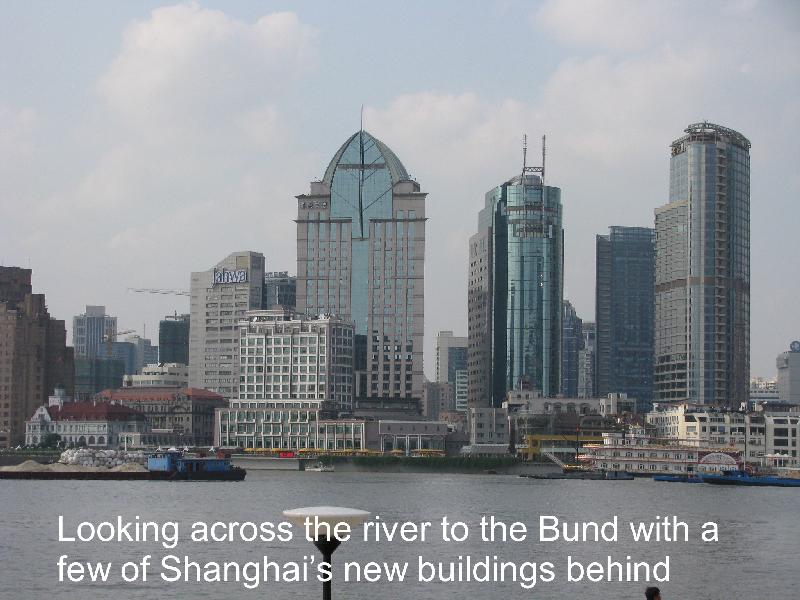
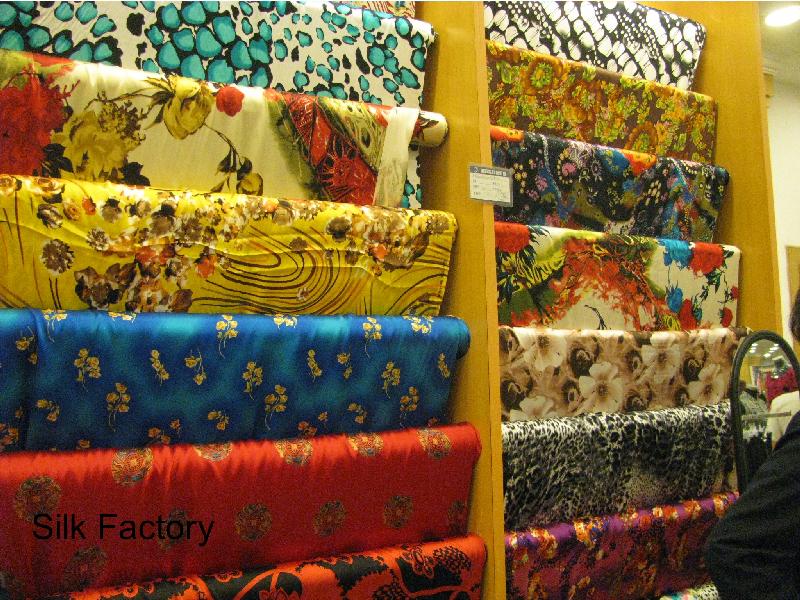
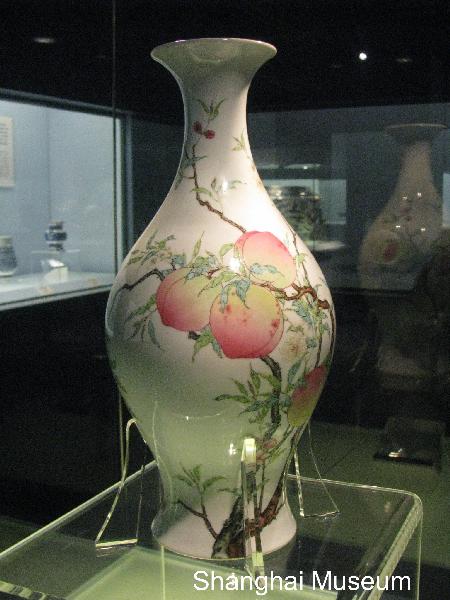
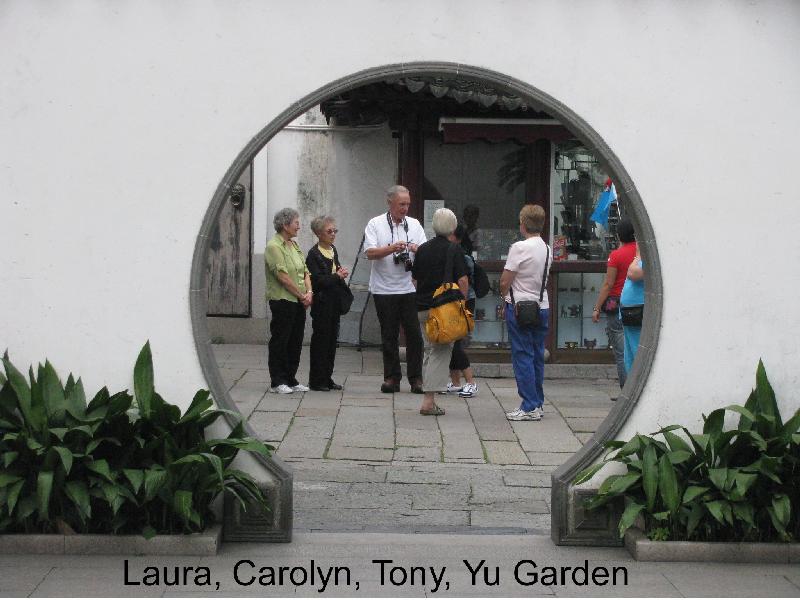
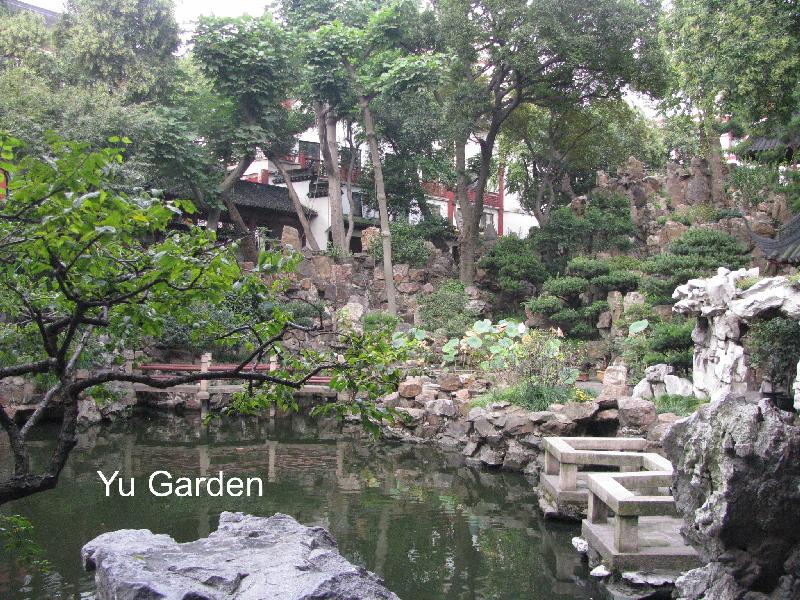
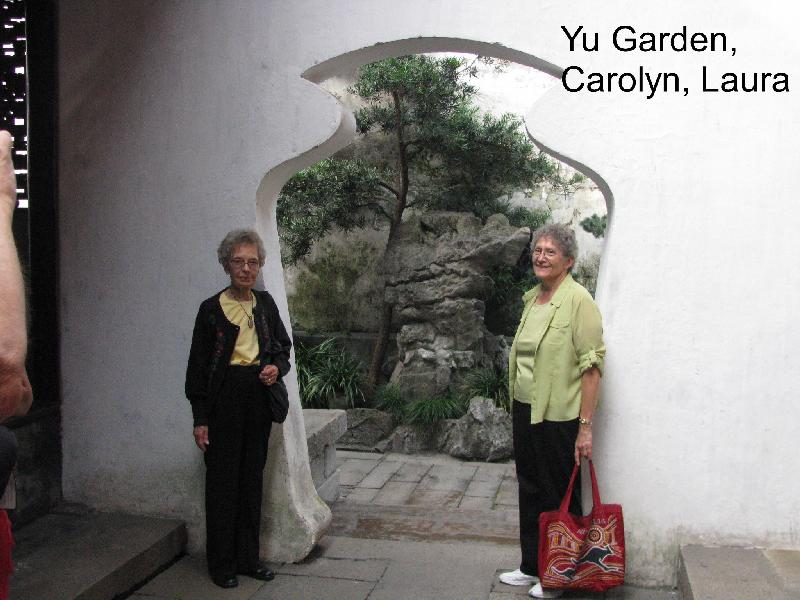
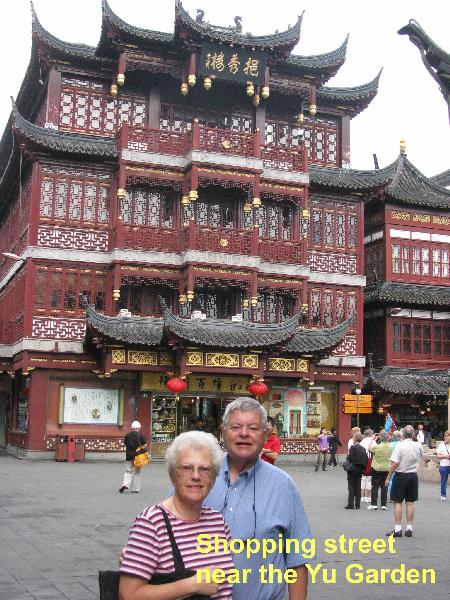
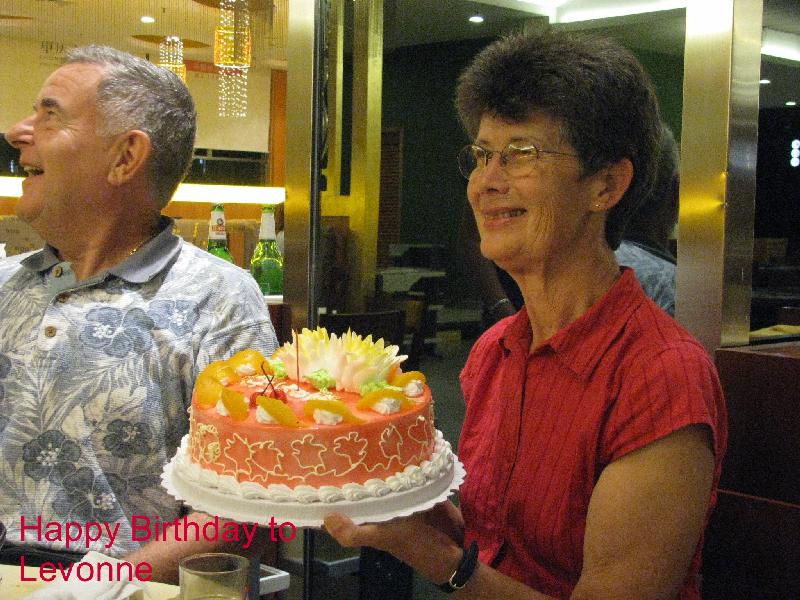
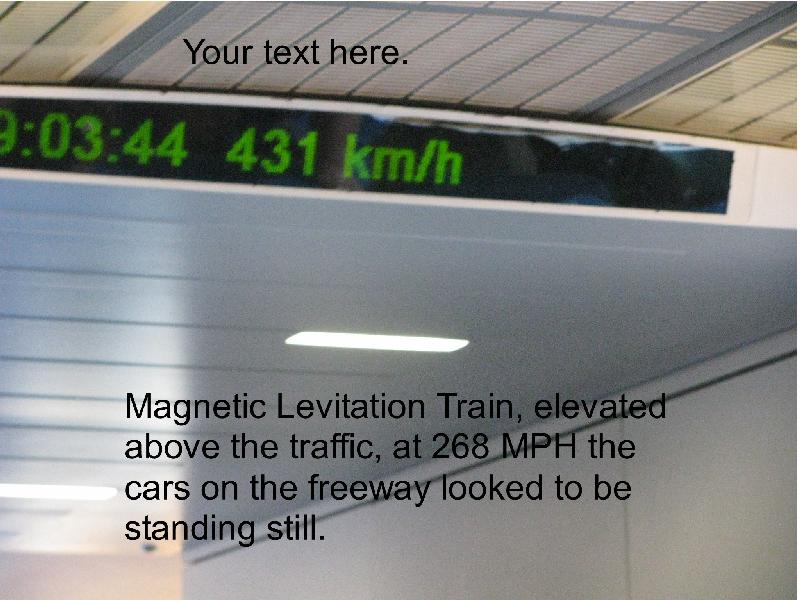
|
|
Yesterday afternoon, we landed in Hong Kong and a guide was at the
gate to meet us, holding up his sign and happy to see that we had
got through customs without a hitch. He had a big bus and a driver
to take us to Kowloon, across the harbor from Hong Kong, to the
Marco Polo Hong Kong Hotel, not to be confused with the other two
Marco Polo hotels in this long block not far from the water. We were
glad to be settled so we could go out and look for something to eat.
We found a little cafť in the enormous shopping center just adjacent
to where weíre staying. Our group is down to 6 now: the Bullards,
Ganos and us.
Hong Kong is a little difficult to fathom at first. Hong Kong
proper is an island of many and is the main part of the city.
Kowloon is across the harbor, a seven minute ferry ride (free for
seniors) and is part of the mainland. It borders the new
territories, and may be encompassed by them. All around are
skyscrapers for both business and apartments. Most everyone here
would live in an apartment, all 7 million of them. Lantau Island is
where the new airport is and has a lot of mountains, beaches and
scenic beauty, where residents could go to get away.
We decided to book an all-day tour to Lantau Island and needed to
be ready to go at 8:20 from the hotel lobby. It is run by Grayline
and collected about 20 others from various hotels. Our first stop
was the ferry terminal where we took a hydro-jet boat to the further
end of the island. Joining us for the boat ride was about 100 10-11
year olds from the International School who were off for a 3 day
camping trip. We understood that they are taught, French, English
and Mandarin Chinese. Most of them were foreigners of the big nose
variety. They stayed on the first level and we could go upstairs
where it was more peaceful. It was about a 20 minute ride. More and
more commute now because the ride used to be an hour and a quarter
by regular ferry.
At the terminal, we boarded another bus for a nice drive on hilly
windy roads to an ancient fishing village, which survives mostly on
tourists. One of the oldest Buddhist temples is in this town. We saw
lots of dried fish along the walk and our guide could point out
things like fish bladders, scallops, sea urchins, sea cucumbers, sea
horses, all dried. This was one place the salespersons didnít come
running out to try to sell us something. They knew it was a lost
cause. All the streets are small and crooked, and the people mostly
walk, bicycle or push carts. At one point we crossed a river about
25 ft wide which until recently didnít have a bridge. They used a
ferry and the family on one side used a rope to pull it back and
forth.
Our next stop was to visit a beach for a few minutes. We could go
down the steps and dip out toe in the South China Sea. It was kind
of rough and no one was swimming today. Shortly they will close the
beaches for the season, and take in the shark nets. The water was
warm. Hong Kong is in the south of China and is a sub-tropical
country. Summer is the rainy season, and they get a fair amount of
rain.
A little further on, we reached the Po Lin Monastery, a Buddhist
institution founded about a hundred years ago by monks from China.
In 1993 was build the Tan Tien statue of Buddha. We were driven up
to it and could go inside to view art and relics, including a tiny
piece of the Buddha, about like a grain of rice. We saw the hundreds
of steps most visitors must climb.
Our lunch was in the restaurant which only serves vegan meals.
Someone had warned us about the soup, but we found it very delicious
with tofu, corn, and mushroom in a thickened brothókind of an
eggless, egg flower soup. We found it all very tasty and decided we
didnít miss the often unidentifiable meat in Chinese cooking. There
were small rolls of bread that were supposed to be dipped in
sweetened soy milk. We enjoyed getting acquainted with 3 Australian
women, grandmother, mother and daughter who had flown from Sydney
for a 5 day shopping tripó9 hours(!). some dedicated shoppers, they.
From the monastery, we could walk to a 5.7 km. aerial tram to get
back down to sea level. We were all a little nervous at first,
especially since it stopped and we started going backward. We were
assured by a loudspeaker that it was normal and necessary to adjust
the cables. As you get over the crest of the mountain, you have a
spectacular view of the airport before descending to the lower
terminal. A bus was waiting to take us back to our hotel. We enjoyed
this trip very much. It was helpful to have a guide who could tell
us about Hong Kong.
Hong Kong was a British crown colony until 1997 when an agreement
was implemented to turn it over to the Chinese. Part of the deal was
that for 50 years, the Chinese would let Hong Kong continue to
manage its affairs in much the same manner as it had. Many people
had British passports and now can apply for Chinese so many have
dual citizenship. The guide seemed to think everything was working
out fine. For us, it was like entering another country and they use
Hong Kong dollars rather than the Chinese Yuan.
Tonight we had dinner at the Dan Ryanís Chicago Grill. It said
the portions were American-sized and they werenít kidding. After
dinner we just had time to walk to the other side of the ferry
terminal to see a spectacular sound and light show. We stood on a
platform overlooking the harbor across to Hong Kong Island and as
the music played, lights on the buildings danced to the music. It
lasted for about 10 minutes and was spectacular. We were wearing
coats tonight, but that was only inside where the air conditioning
is turned up. We take them off when we go outside.
Tomorrow we plan our last full day of sightseeing on the island
of Hong Kong.
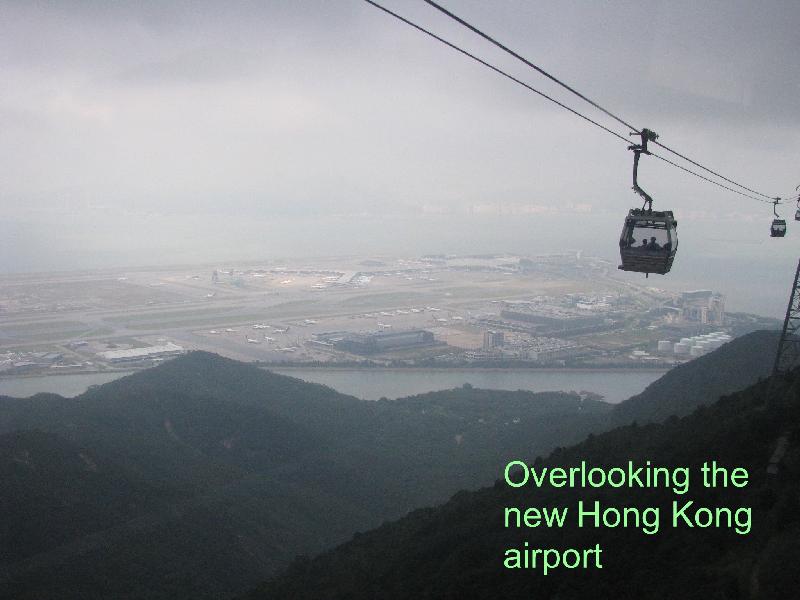
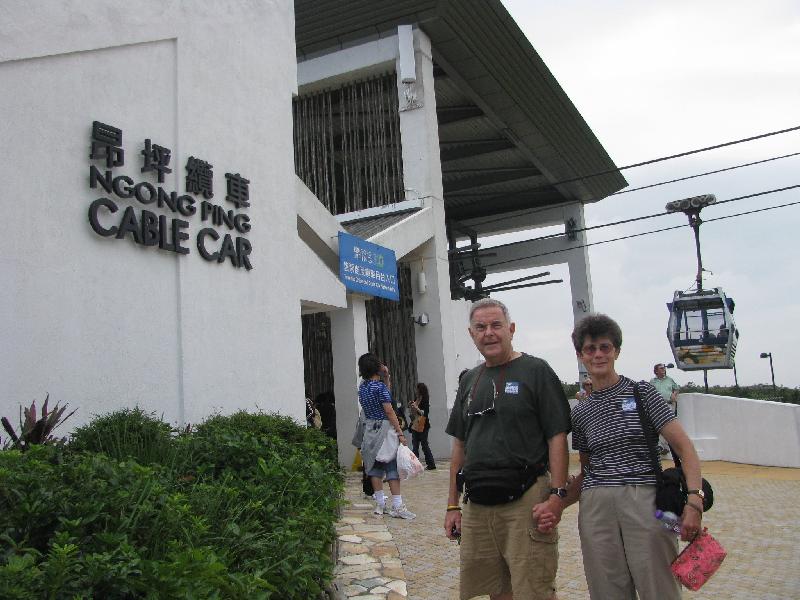
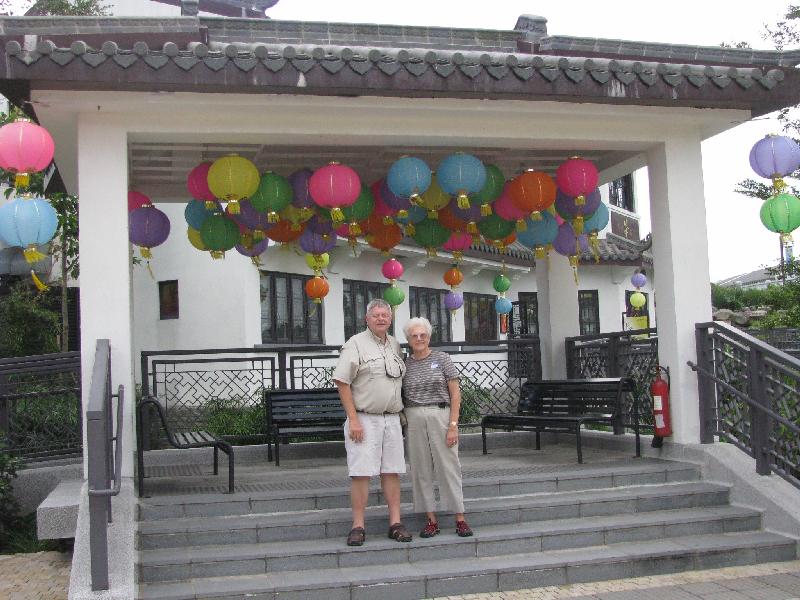
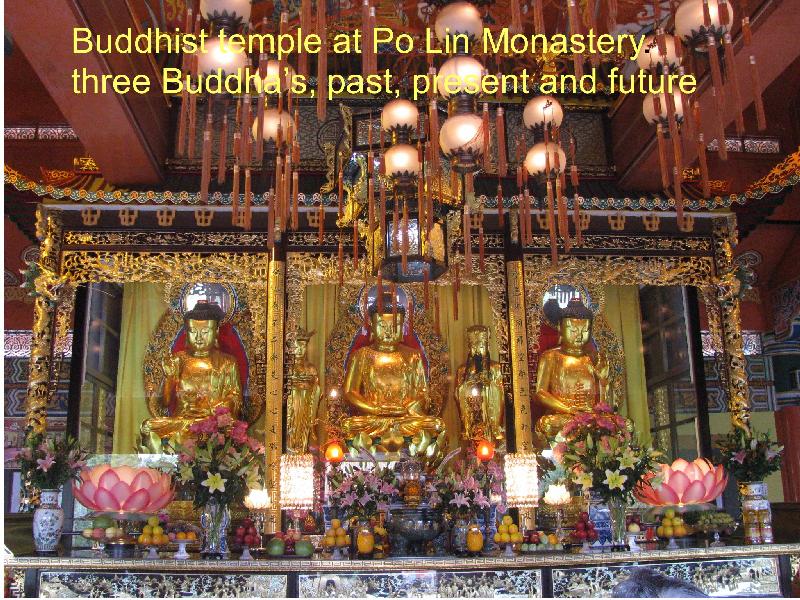
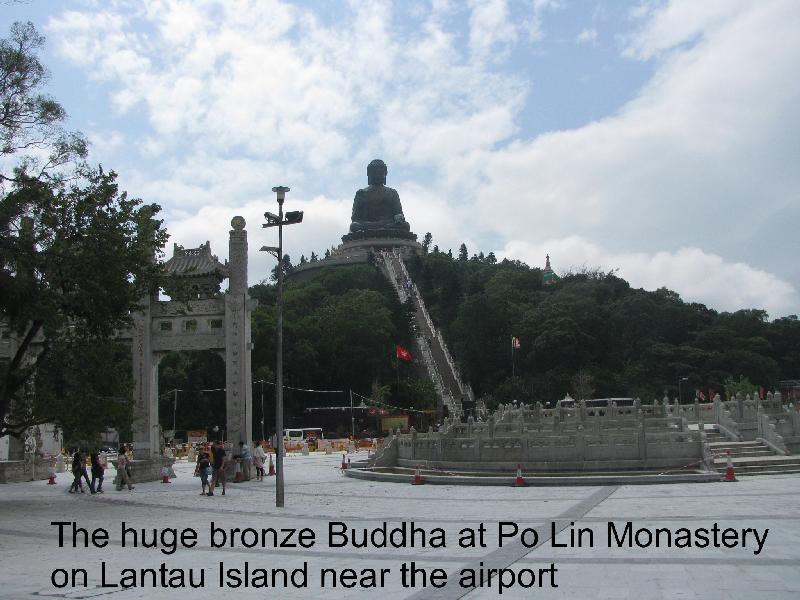
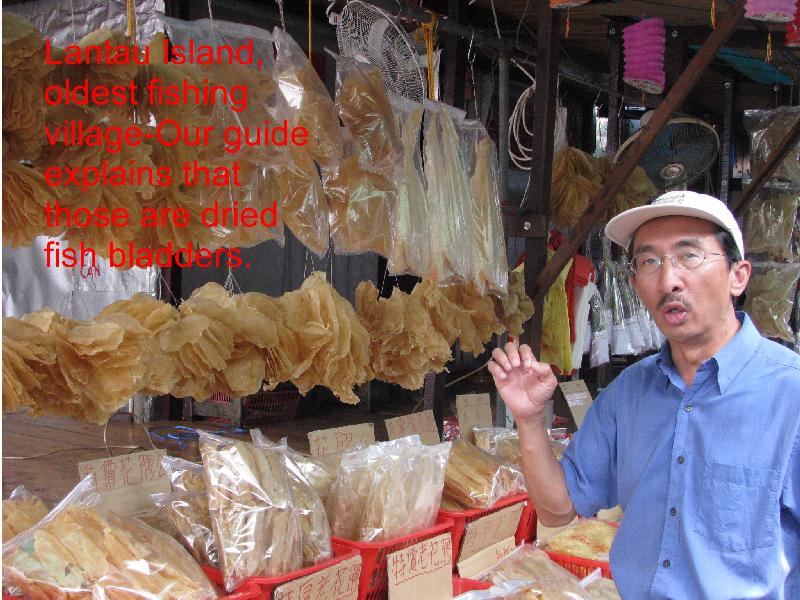

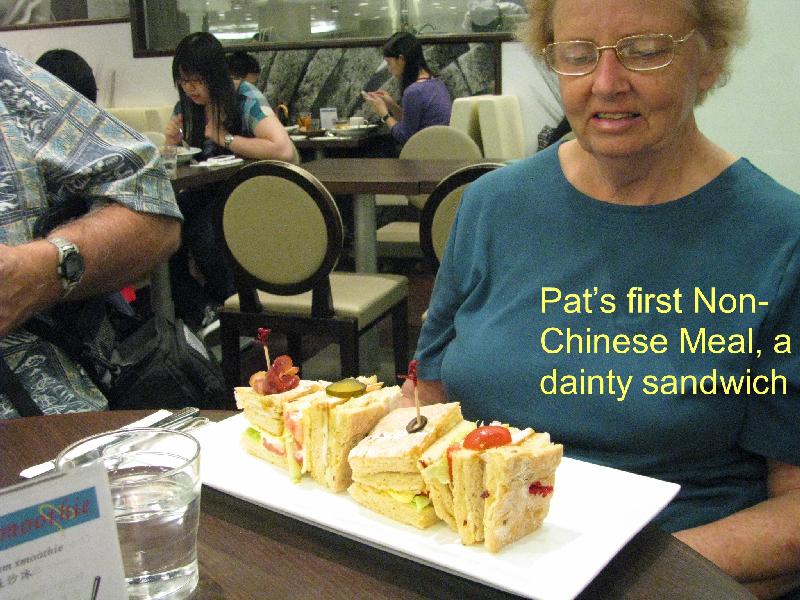
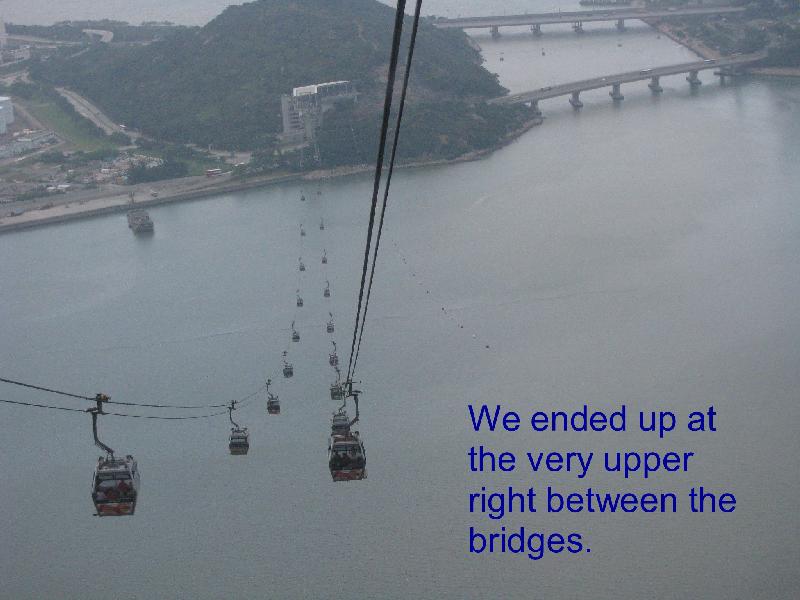
|
|
I
neglected to mention yesterday that the bronze Buddha we saw
yesterday is the largest seated bronze Buddha in the world. It is
impressive and placed in an advantageous setting.
Our last full day in Asia began with a ferry ride across the bay
to Hong Kong from Kowloon. It is a commuter passenger ferry and
takes only a few minutes. If we had been more assertive I think we
could have ridden free as honored citizens, but as it was, it only
cost about 25 cents. We had stopped at a tourist office just
outside, and the girl on duty sketched out a route for us to take.
We were impressed because she could write so rapidly upside down.
From the ferry, we walked a couple blocks to the bus terminal. We
found that we needed exact change so we went to the bank where they
painstakingly counted out various coins and bills. The Hong Kong
dollar is worth about 13 cents and I do believe they have the
ugliest coins I have ever seen. We found our bus and began a
hair-raising drive in a double-decker bus to Stanley on the other
side of the island. We went through the Aberdeen Tunnel and wound
over hill and dale missing the concrete walls by inches. The other
side was a sheer cliff. The market was very interesting with
hundreds of small shops for browsing and buying. About noon, we
decided we had had enough and took the bus back to downtown. This
driver was a little saner, and I think I actually took a short nap.
Our destination was the famous set of escalators that go for
blocks and blocks up the hill. In the morning until 10:20, they move
downward. After that, they reverse. We went up part way to see what
it was like, then veered off to find the terminal for the Tram to
the Peak. Since 1888, there has been a tram pulled by cables to take
120 people at a time up the steep hill from near sea level to over
1200 feet. Often it feels like about a 45 degree angle, but I think
it was only 17, as one goes past the high rise apartments. At the
top is a new visitors center with an outdoor viewing platform
containing many restaurants and shops. It is possible to drive up to
Victoria Peak from the backside.
It was a mostly sunny day, and we had spectacular views from a
vista as high as the highest new buildings. We could see our hotel
in Kowloon. All this for about $3 per person for honored citizens.
After a few hours, we took the cars back down and found a bus to the
ferry to get back to our hotel. The Bullardís had spent the day in
Kowloon and were waiting for us to join them for dinner.
We are back in our rooms resting up for the long journey home
tomorrow. I has been a truly amazing journey full of variety and
fascinating experiences. This is the second trip we have taken with
Goway Travel, and we are always impressed with their service. This
was our first fully guided trip, and a lot was packed into each day.
I felt that our guides wanted to make sure we didnít miss a thing.
There were times when I wanted to slow down, but then we would have
had to miss something, and I donít know what I would have left out.
China has a lot of energy and is catching up at an amazing rate. Our
guides were optimistic and seemed to be happy with their lives. We
hope to return to Asia some day, but maybe to other countries and
cities. There is so much to see and so little time. By now, Iím sure
youíre heaving a sigh of relief that we are finally getting home and
you wonít have this to bombard you every day or so.
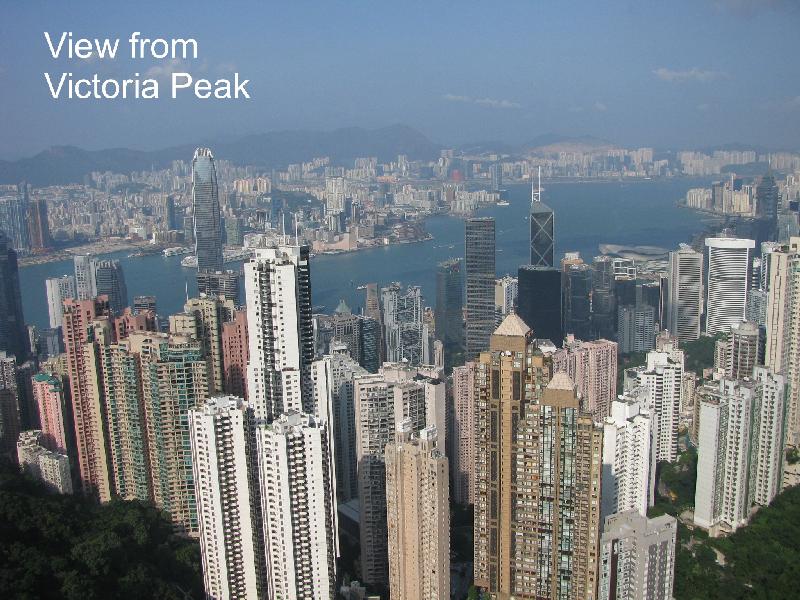
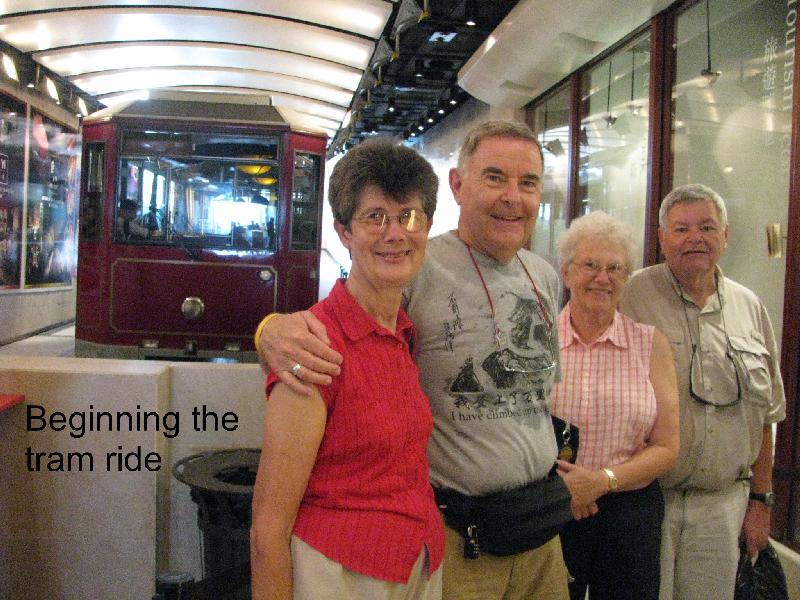
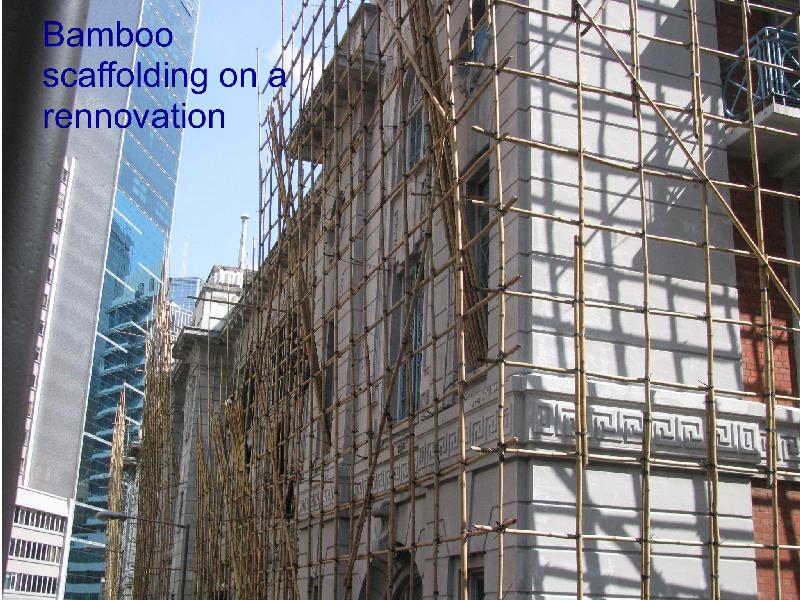
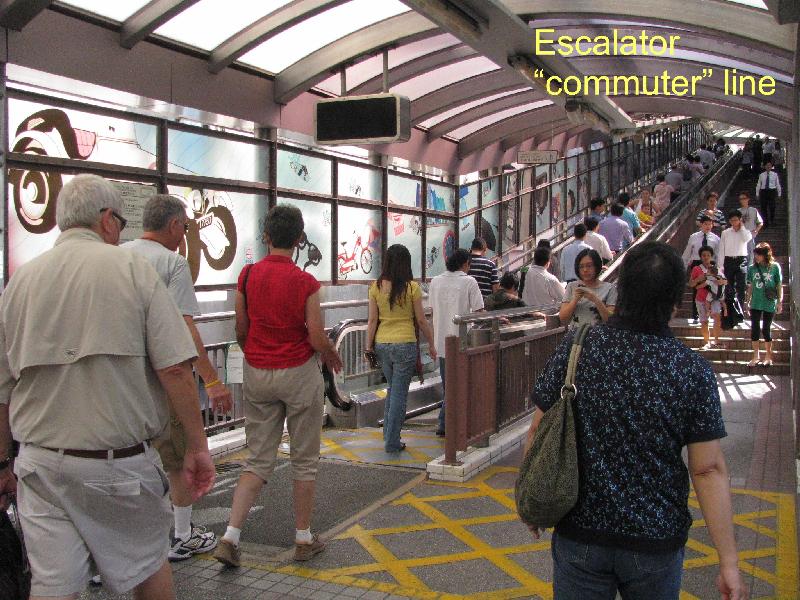
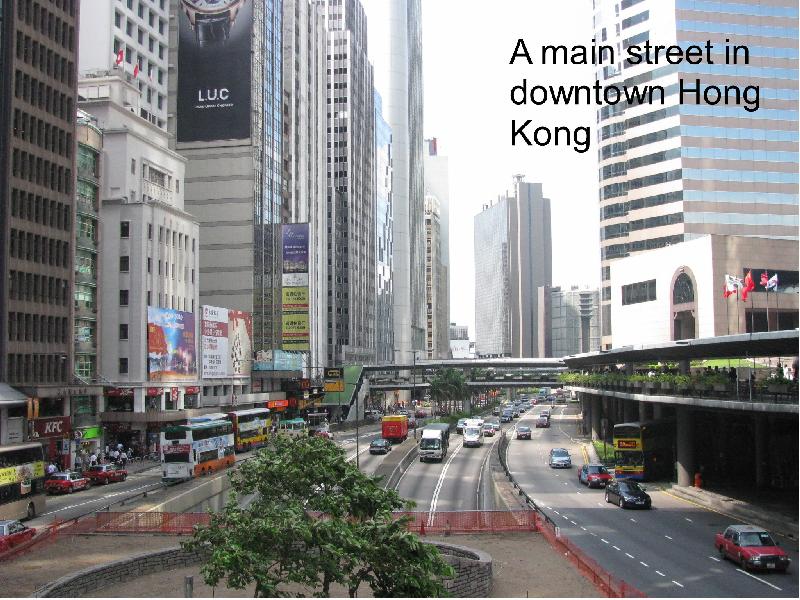
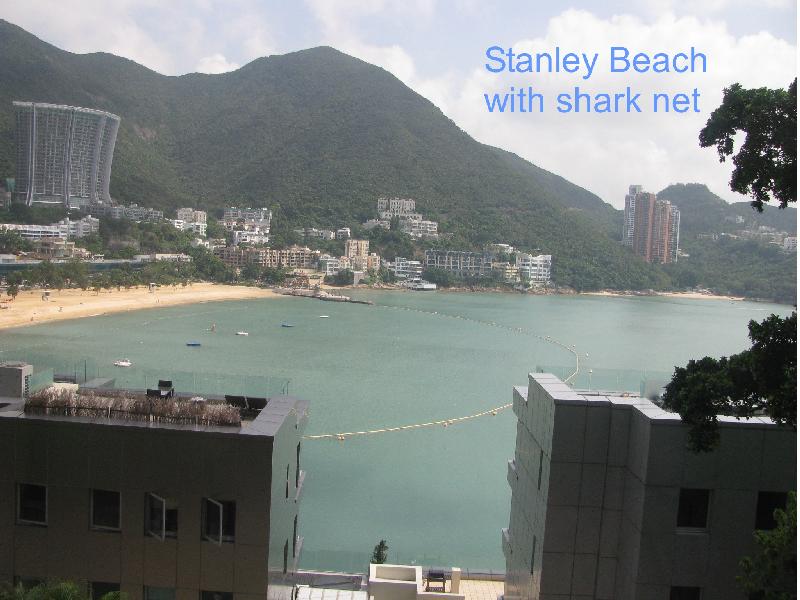

|
This site was last updated
10/19/09
|
